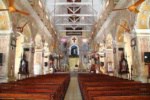57 Popular Hindu temples across the world
The ancient civilization and culture of India, known for sculpture, architecture, and architecture, has shown its beauty to itself through buildings, palaces as well as religious places. So in this list today, we have brought you information about the most famous temples of India, which are known around the world for their grand darshan.
When it comes to religion and spirituality, India simply has no competition. The amazing land of diversity boasts of diverse cultures, faiths, and many beautiful temples. Some of these temples- the stunning, serene spaces of worship – are famous globally owing to their impeccable beauty. They are significant religious and historic landmarks that are intricately designed and devotedly maintained. They are must-see pieces of art for all those who have an interest in Indian culture, history, and heritage. Here, you can find a list of famous Hindu temples that showcase genius of the ancient architects and engineers. These temples are made in a great variety of styles. They have remained integral to the Indian ethos and sentiments. Some of them evolved over the years to wield enormous power and wealth as well. Unparalleled in their artistic splendor, they incredibly contribute to the cultural and architectural heritage of the country.
Akshardham Temple, Delhi
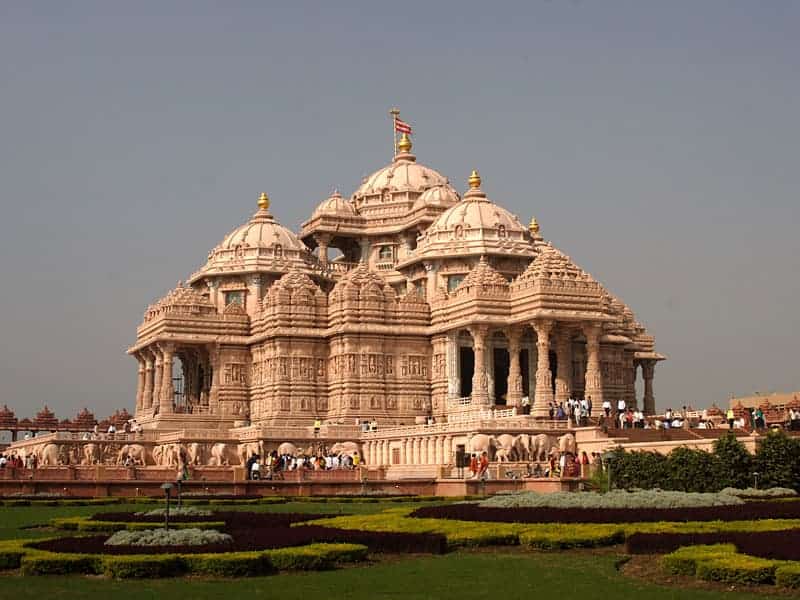
Swaminarayan Akshardham (New Delhi) is a Hindu temple, and a spiritual-cultural campus in New Delhi, India. Also referred to as Akshardham Temple or Delhi Akshardham, the complex displays millennia of traditional and modern Hindu culture, spirituality, and architecture. Inspired by Yogiji Maharaj and created by Pramukh Swami Maharaj, it was constructed by BAPS. The temple was officially opened on 6 November 2005 by Pramukh Swami Maharaj in the presence of Dr. A. P. J. Abdul Kalam, Manmohan Singh, L.K Advani and B.L Joshi. The temple, at the centre of the complex, was built according to the Vastu shastra and Pancharatra shastra.
In Swaminarayan Akshardham New Delhi, similar to its predecessor Swaminarayan Akshardham in Gandhinagar, Gujarat, the main shrine is the focal point and maintains the central position of the entire complex. There are various exhibition halls which provide information about the life and work of Swaminarayan. The designers of the complex have adopted contemporary modes of communication and technology to create the various exhibition halls.The complex features an abhishek mandap, Sahaj Anand water show, a thematic garden and three exhibitions namely Sahajanand Darshan (Hall of Values), Neelkanth Darshan (an IMAX film on the early life of Swaminarayan as the teenage yogi, Neelkanth), and Sanskruti Darshan (cultural boat ride). According to Swaminarayan Hinduism, the word Akshardham means the abode of Swaminarayan and believed by followers as a temporal home of God on earth.
Read More About Akshardham Temple, Delhi / Source
Jagannath Temple Puri, odisha

The Shree Jagannath Temple is an important Hindu temple dedicated to Jagannath, a form of Vishnu, in Puri in the state of Odisha on the eastern coast of India. The present temple was rebuilt from the 10th century onwards, on the site of an earlier temple, and begun by King Anantavarman Chodaganga Deva, first of the Eastern Ganga dynasty. The Puri temple is famous for its annual Ratha yatra, or chariot festival, in which the three principal deities are pulled on huge and elaborately decorated temple cars. These gave their name to the English term ‘Juggernaut’. Unlike the stone and metal icons found in most Hindu temples, the image of Jagannath is made of wood and is ceremoniously replaced every twelve or nineteen years by an exact replica. It is one of the Char Dham.
The temple is sacred to all Hindus and especially in those of the Vaishnava traditions. Many great saints, such as Ramananda and Ramanuja, were closely associated with the temple. Ramanuja established the Emar Mutt near the temple and Adi Shankaracharya established the Govardhana Mutt, which is the seat of one of the four Shankaracharyas. It is also of particular significance to the followers of the Gaudiya Vaishnavism whose founder Chaitanya Mahaprabhu, was attracted to the deity, Jagannath, and lived in Puri for many years.
Read More About Jagannath Temple Puri, odisha / Source
Kamakhya Devi Temple, Assam

The Kamakhya Temple also known as Kamrup-Kamakhya temple, is a Sakta temple dedicated to the mother goddess Kamakhya. It is one of the oldest of the 51 Shakti Pithas. Situated on the Nilachal Hill in western part of Guwahati city in Assam, India, it is the main temple in a complex of individual temples dedicated to the ten Mahavidyas of Saktism : Kali, Tara, Sodashi, Bhuvaneshwari, Bhairavi, Chhinnamasta, Dhumavati, Bagalamukhi, Matangi and Kamalatmika. Among these, Tripurasundari, Matangi and Kamala reside inside the main temple whereas the other seven reside in individual temples. It is an important pilgrimage destination for Hindus and especially for Tantric worshipers.
In July 2015, the Supreme Court of India transferred the administration of the Temple from the Kamakhya Debutter Board to the Bordeuri Samaj.
Read More About Kamakhya Devi Temple, Assam / Source
Tirupati Balaji, Andhra Pradesh

Venkateswara Temple is a Hindu temple situated in the hill town of Tirumala at Tirupati in Chittoor district of Andhra Pradesh, India. The Temple is dedicated to Venkateswara, a form of Vishnu, who is believed to have appeared here to save mankind from trials and troubles of Kali Yuga. Hence the place has also got the name Kaliyuga Vaikuntham and the Lord here is referred to as Kaliyuga Prathyaksha Daivam. The temple is also known by other names like Tirumala Temple, Tirupati Temple, Tirupati Balaji Temple. Venkateswara is known by many other names: Balaji, Govinda, and Srinivasa.The temple is run by body Tirumala Tirupati Devasthanams (TTD) which is under direct control of Andhra Pradesh Government. The head of TTD is appointed by Andhra Pradesh Government. The revenue from this shrine is used by Andhra Pradesh government.Tirumala Hills are part of Seshachalam Hills range. The hills are 853 metres (2,799 ft) above sea level. The Hills comprises seven peaks, representing the seven heads of Adisesha. The temple lies on the seventh peak -Venkatadri, on the southern banks of Sri Swami Pushkarini, a holy water tank. Hence the temple is also referred to as “Temple of Seven Hills”. Tirumala town covers about 10.33 sq mi (26.75 km2) in area.
The Temple is constructed in Dravidian architecture and is believed to be constructed over a period of time starting from 300 AD. The Garbagruha (Sanctum Sanctorum) is called AnandaNilayam. The presiding deity, Venkateswara, is in standing posture and faces east in Garbha gruha. The temple follows Vaikhanasa Agama tradition of worship. The temple is one of the eight Vishnu Swayambhu Kshetras and is listed as 106th and the last earthly Divya Desam. The Temple premises had two modern Queue complex buildings to organise the pilgrim rush, Tarigonda Vengamamba Annaprasadam complex for free meals to Pilgrims, hair tonsure buildings and a number of pilgrim lodging sites.
It is the richest temple in the world in terms of donations received and wealth. The temple is visited by about 50,000 to 100,000 pilgrims daily (30 to 40 million people annually on average), while on special occasions and festivals, like the annual Brahmotsavam, the number of pilgrims shoots up to 500,000, making it the most-visited holy place in the world.. In 2016, it was reported that 27.3 million pilgrims visited the temple.It is around 435 km (270.3 mi) from Vijayawada, 571.9 km (355.4 mi) from Hyderabad, 138 km (85.7 mi) from Chennai, 291 km (180.8 mi) from Bangalore, and 781.2 km (485.4 mi) from Visakhapatnam
There are several legends associated with the manifestation of the Lord in Tirumala. According to one legend, the temple has a murti (deity) of Venkateswara, which it is believed shall remain here for the entire duration of the present Kali Yuga.
Read More About Tirupati Balaji, Andhra Pradesh / Source
Brihadeeswarar Temple Thanjavur, Tamil Nadu

Brihadishvara Temple, also called Rajarajesvaram or Peruvudaiyār Kōvil, is a Hindu temple dedicated to Shiva located in South bank of Kaveri river in Thanjavur, Tamil Nadu, India. It is one of the largest South Indian temples and an exemplary example of a fully realized Dravidian architecture. It is called as Dhakshina Meru (Meru of south). Built by Tamil king Raja Raja Chola I between 1003 and 1010 AD, the temple is a part of the UNESCO World Heritage Site known as the “Great Living Chola Temples”, along with the Chola dynasty era Gangaikonda Cholapuram temple and Airavatesvara temple that are about 70 kilometres (43 mi) and 40 kilometres (25 mi) to its northeast respectively.The original monuments of this 11th century temple were built around a moat. It included gopura, the main temple, its massive tower, inscriptions, frescoes and sculptures predominantly related to Shaivism, but also of Vaishnavism and Shaktism traditions of Hinduism. The temple was damaged in its history and some artwork is now missing. Additional mandapam and monuments were added in centuries that followed. The temple now stands amidst fortified walls that were added after the 16th century.Built out of granite, the vimana tower above the sanctum is one of the tallest in South India. It was, in all likelihood, one of the tallest structures in the world at the time of its construction. The temple has a massive colonnaded prakara (corridor) and one of the largest Shiva lingas in India. It is also famed for the quality of its sculpture, as well as being the location that commissioned the brass Nataraja – Shiva as the lord of dance, in 11th century. The complex includes shrines for Nandi, Parvati, Kartikeya, Ganesha, Sabhapati, Dakshinamurti, Chandeshvara, Varahi and others. The temple is one of the most visited tourist attractions in Tamil Nadu.
Read More About Brihadeeswarar Temple Thanjavur, Tamil Nadu / Source
Meenakshi Temple Madurai, Tamil Nadu

Meenakshi Temple (also referred to as Meenakshi Amman Temple or Meenakshi Sundareshwarar Temple also spelled as Meenaatchi Temple) is a historic Hindu temple located on the southern bank of the Vaigai River in the temple city of Madurai, Tamil Nadu, India. It is dedicated to Thirukamakottam udaya aaludaiya nachiyar (திருக்காமக்கோட்டம் உடைய ஆளுடைய நாச்சியார்) Meenakshi, a form of Parvati, and her consort, Sundareshwar, a form of Shiva. The temple is at the center of the ancient temple city of Madurai mentioned in the Tamil Sangam literature, with the goddess temple mentioned in 6th century CE texts. This temple is one of the Paadal Petra Sthalam. The Paadal Petra sthalam are 275 temples of lord Shiva that are revered in the verses of Tamil Saiva Nayanars of 6th-9th century CE.
Read More About Meenakshi Temple Madurai, Tamil Nadu / Source
Vaishno Devi Temple, Jammu

Vaishno Devi, also known as Mata Rani, Trikuta, Ambe and Vaishnavi, is a manifestation of The Hindu Mother Goddess, Devi. The words “Maa” and “Mata” are commonly used in India for mother, and thus are often heavily used in connection with Vaishno Devi.
Goddess Vaishnavi was formed from the combined energies of Goddess Parvati/Mahakali, Mahalakshmi, and Mahasaraswati.
According to the puranas, during the Treta Yuga (second yuga of Hindu cosmology), evil forces started to threaten the earth. To save herself, Bhumi the Earth Goddess, went to the Trimurti for help. While the three gods were helpless, their consorts — Saraswati, Lakshmi and Parvati (Kali) combined their forces and created a goddess named Vaishno Devi. After numerous battles, the goddess defeated evils and was ordered to stay on earth to protect it.
Read More About Vaishno Devi Temple, Jammu / Source
Somnath Temple, Gujarat
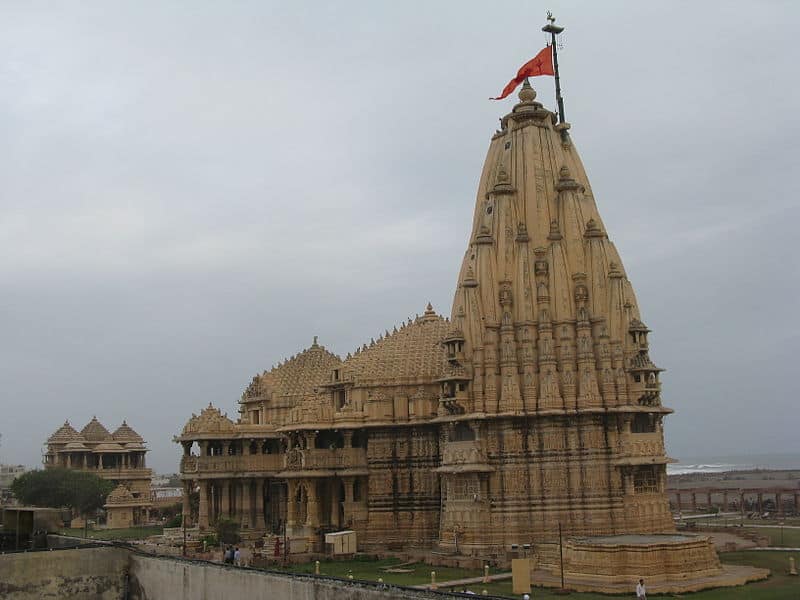
The Somnath temple (also known as the Deo Patan) located in Prabhas Patan near Veraval in Saurashtra on the western coast of Gujarat, India is believed to be the first among the twelve jyotirlinga shrines of Shiva. It is an important pilgrimage and tourist spot of Gujarat. Reconstructed several times in the past after repeated destruction by several invaders and rulers, the present temple was reconstructed in the Chaulukya style of Hindu temple architecture and completed in May 1951. The reconstruction was started under the orders of the Home Minister of India Vallabhbhai Patel and completed after his death.
Read More About Somnath Temple, Gujarat / Source
Kashi Vishwanath Varanasi, Uttar Pradesh
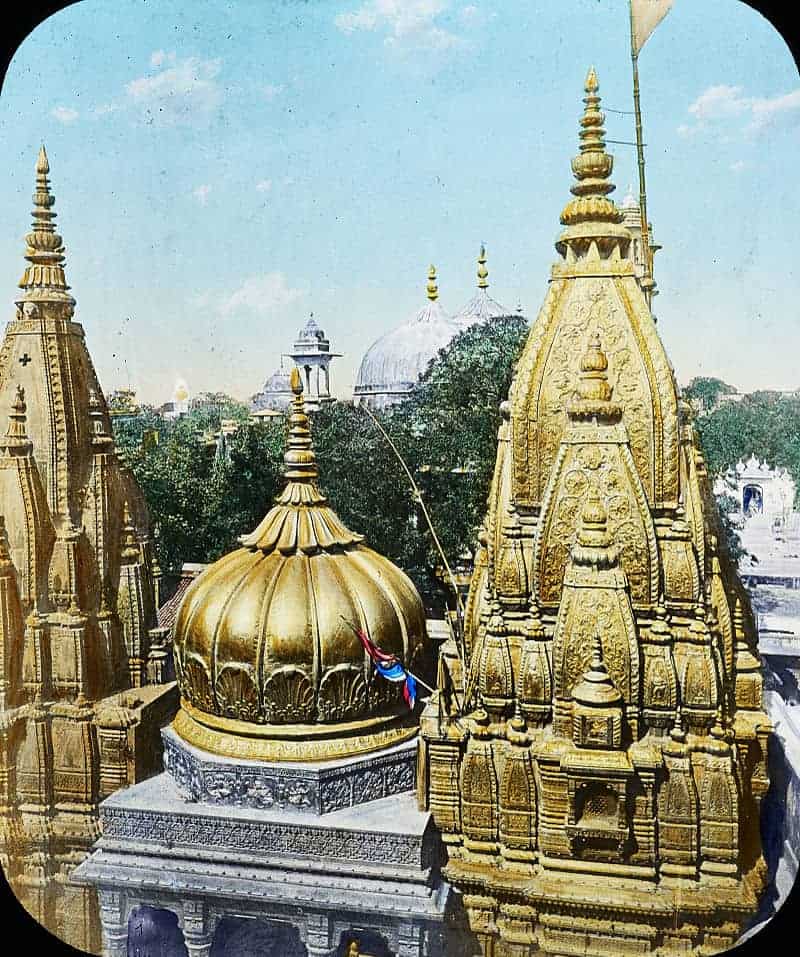
Kashi Vishwanath Temple is one of the most famous Hindu temples dedicated to Lord Shiva. It is located in Vishwanath Gali of Varanasi, Uttar Pradesh, India. The Temple stands on the western bank of the holy river Ganga, and is one of the twelve Jyotirlingas, or Jyotirlingams, the holiest of Shiva Temples. The main deity is known by the names Shri Vishwanath and Vishweshwara (IAST: Vishveshvara) literally meaning Lord of the Universe. Varanasi city was called Kashi in ancient times, and hence the temple is popularly called Kashi Vishwanath Temple. The etymology of the name Vishveshvara is Vishva: Universe, Ishvara: lord, one who has dominion.
The Temple has been referred to in Hindu scriptures for a very long time as a central part of worship in the Shaiva Philosophy. It has been destroyed and re-constructed a number of times in history. The last structure was demolished by Aurangzeb, the sixth Mughal emperor who constructed the Gyanvapi Mosque on its site. The current structure was built on an adjacent site by the Maratha ruler, Ahilya Bai Holkar of Indore in 1780.Since 1983, the temple has been managed by the government of Uttar Pradesh. During the religious occasion of Shivratri, Kashi Naresh (King of Kashi) is the chief officiating priest.
Read More About Kashi Vishwanath Varanasi, Uttar Pradesh / Source
Dakshineswar Kali Temple, Kolkata
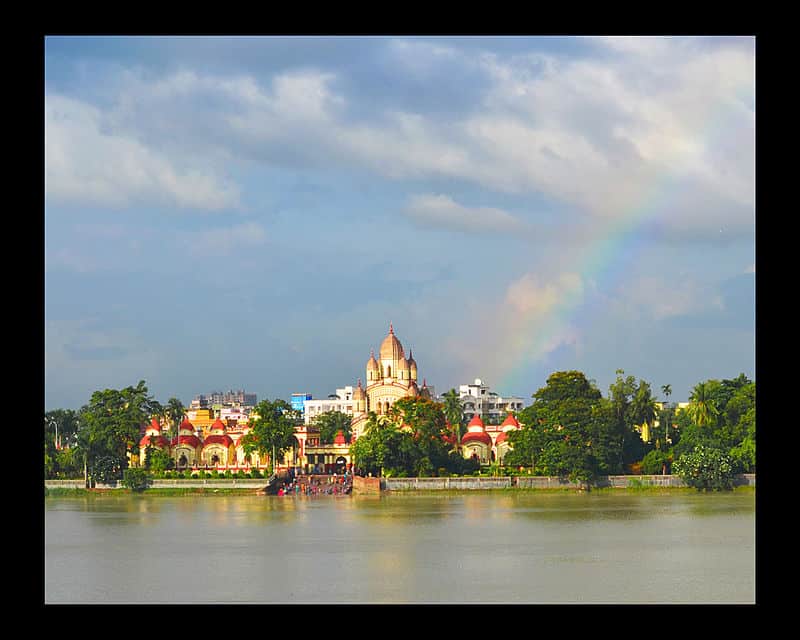
Dakshineswar Kali Temple is a Hindu navaratna temple located at Dakshineswar. Situated on the eastern bank of the Hooghly River, the presiding deity of the temple is Bhavatarini, an aspect of Kali, who is form of Adi Shakti. The temple was built in 1854-55 by Rani Rashmoni, a philanthropist and a devotee of Kali. The temple is known for its association with Ramakrishna and Ma Sarada Devi, mystics of 19th Century Bengal.The temple compound, apart from the nine-spired main temple, contains a large courtyard surrounding the temple, with rooms along the boundary walls. There are twelve shrines dedicated to Shiva—Kali’s companion—along the riverfront, a temple to Radha-Krishna, a bathing ghat on the river, a shrine dedicated to Rani Rashmoni. ‘Nahabat’, the chamber in the northwestern corner just beyond the last of the Shiva temples, is where Ramakrishna and Maa Sarada spent a considerable part of their lives.
Read More About Dakshineswar Kali Temple, Kolkata / Source
Belur Math, Ramakrishna temple

Beluṛ Maṭh is the headquarters of the Ramakrishna Math and Ramakrishna Mission, founded by Swami Vivekananda, the chief disciple of Ramakrishna Paramahamsa. It is located on the west bank of Hooghly River, Belur, West Bengal, India and is one of the significant institutions in Kolkata. This temple is the heart of the Ramakrishna Movement. The temple is notable for its architecture that fuses Christian, Islamic, Hindu and Buddhist art motifs as a symbol of unity of all religions. In 2003 Belur Math railway station was also inaugurated which is dedicated to Belur Math Temple.
Read More About Belur Math, Ramakrishna temple / Source
Sita Ramachandraswamy temple, Bhadrachalam
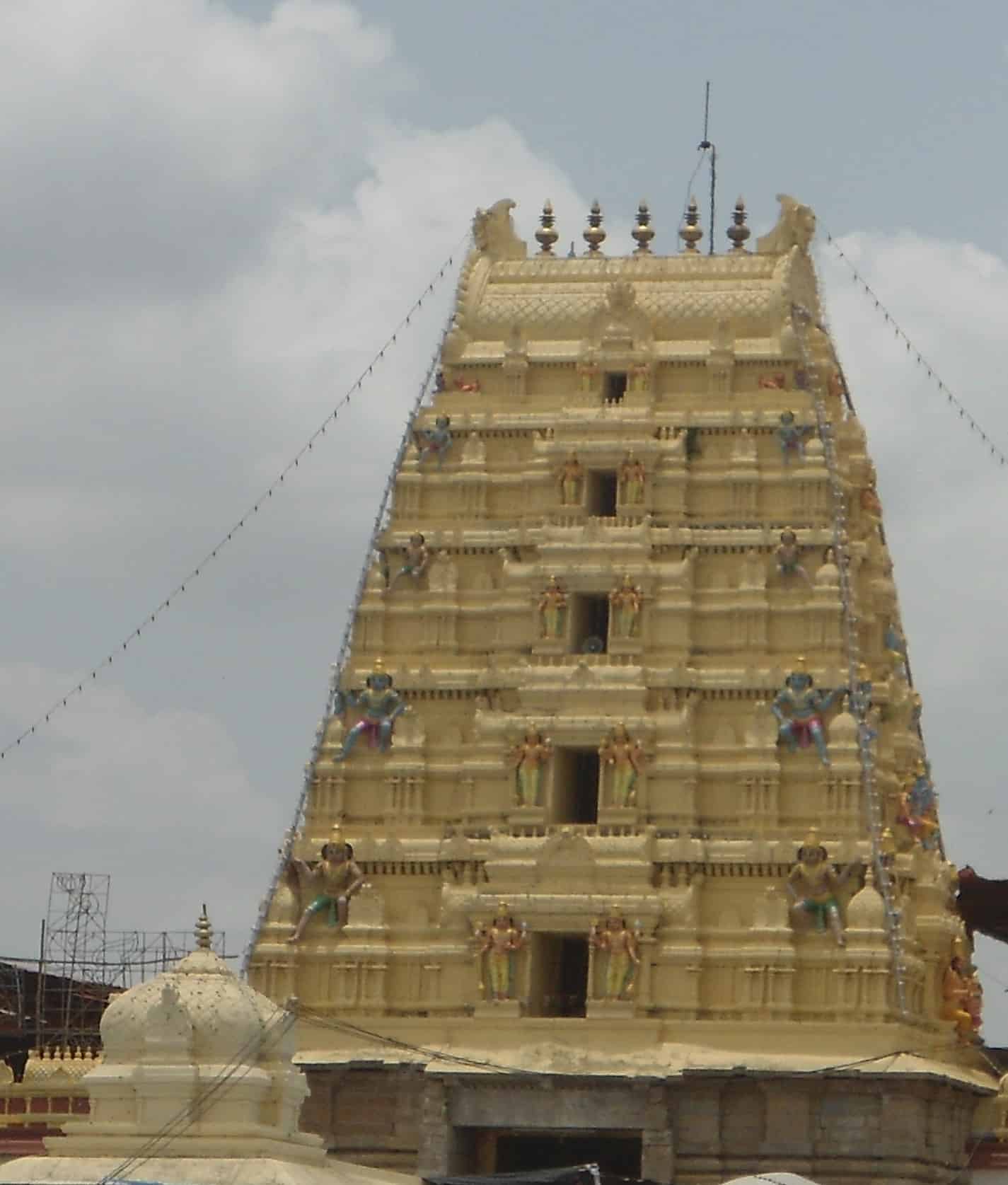
The Sri Sita Ramachandraswamy temple is a South Indian Hindu temple dedicated to Rama, the seventh incarnation of the god Vishnu. It is located on the shores of the Godavari River in the town of Bhadrachalam, a part of the Bhadradri Kothagudem district in Telangana state. Often simply referred to as Bhadrachalam or Bhadradri, the temple is considered one of the Divya Kshetrams of Godavari and is also revered as Dakshina Ayodhya. According to the legend, Vishnu appeared to Meru’s son Bhadra as Rama to answer the latter’s prayers. However, Vishnu forgot that Rama was a mortal human and appeared as Vaikuntha Rama with four hands. Sita and Lakshmana form part of the temple’s moolavar.
Read More About Sita Ramachandraswamy temple, Bhadrachalam / Source
Prem Mandir, Vrindavan
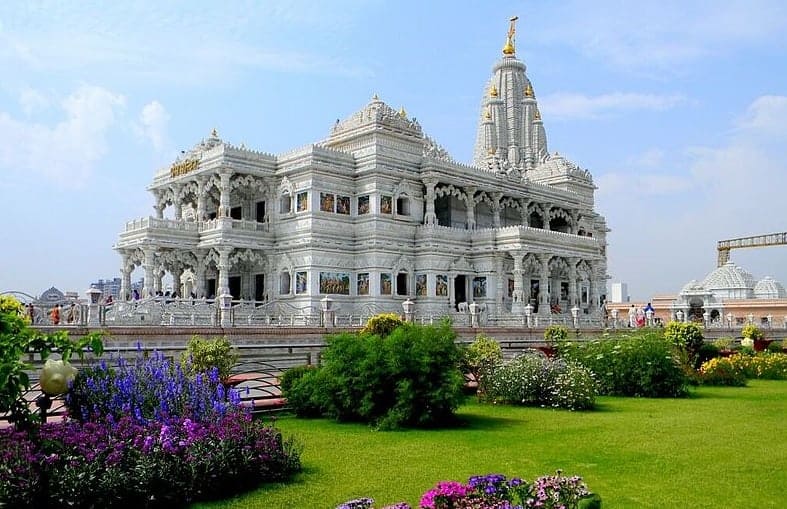
Prem Mandir (lit. The Temple of Divine Love) is a Hindu temple in Vrindavan, Mathura, India. It is maintained by Jagadguru Kripalu Parishat, an international non-profit, educational, spiritual, charitable trust.
The complex is on a 55-acre site on the outskirts of Vrindavan, and is dedicated to Lord Radha Krishna and Sita Ram, Radha Krishna on the first level and Sita Ram on the second level.
The temple structure was established by the fifth Jagadguru, Kripalu Maharaj. Figures of Shri Krishna and his followers depicting important events surrounding the Lord’s existence cover the main temple..
Construction began in January 2001 and the inauguration ceremony took place from 15 February to 17 February 2012. The temple was opened to public on 17 February. The cost was 150 crore rupees ($23 million). The presiding deity are Shri Radha Govind (Radha Krishna) and Shri Sita Ram. A 73,000 square feet, pillar-less, dome shaped satsang hall is being constructed next to Prem Mandir, which will accommodate 25,000 people at a time. Surrounded by beautiful gardens and fountains, the temple complex has life-size depictions of four leelas of Shri Krishna – Jhulan leela, Govardhan leela, Raas leela and Kaliya Naag leela.
It is sister temple of Bhakti Mandir which was opened in 2005 and another sister temple which is known as Kirti Mandir, Barsana opened in 2019.
Read More About Prem Mandir, Vrindavan / Source
Hindu Temple of Delaware

Hindu Temple of Delaware at 760 Yorklyn Road, Hockessin is one of many Hindu temples in the USA. The main deity is Goddess Mahalakshmi, the Goddess of wealth and prosperity. There are over 7,000 families in Delaware Valley area who visit this temple annually.
Read More About Hindu Temple of Delaware / Source
Koneswaram Temple
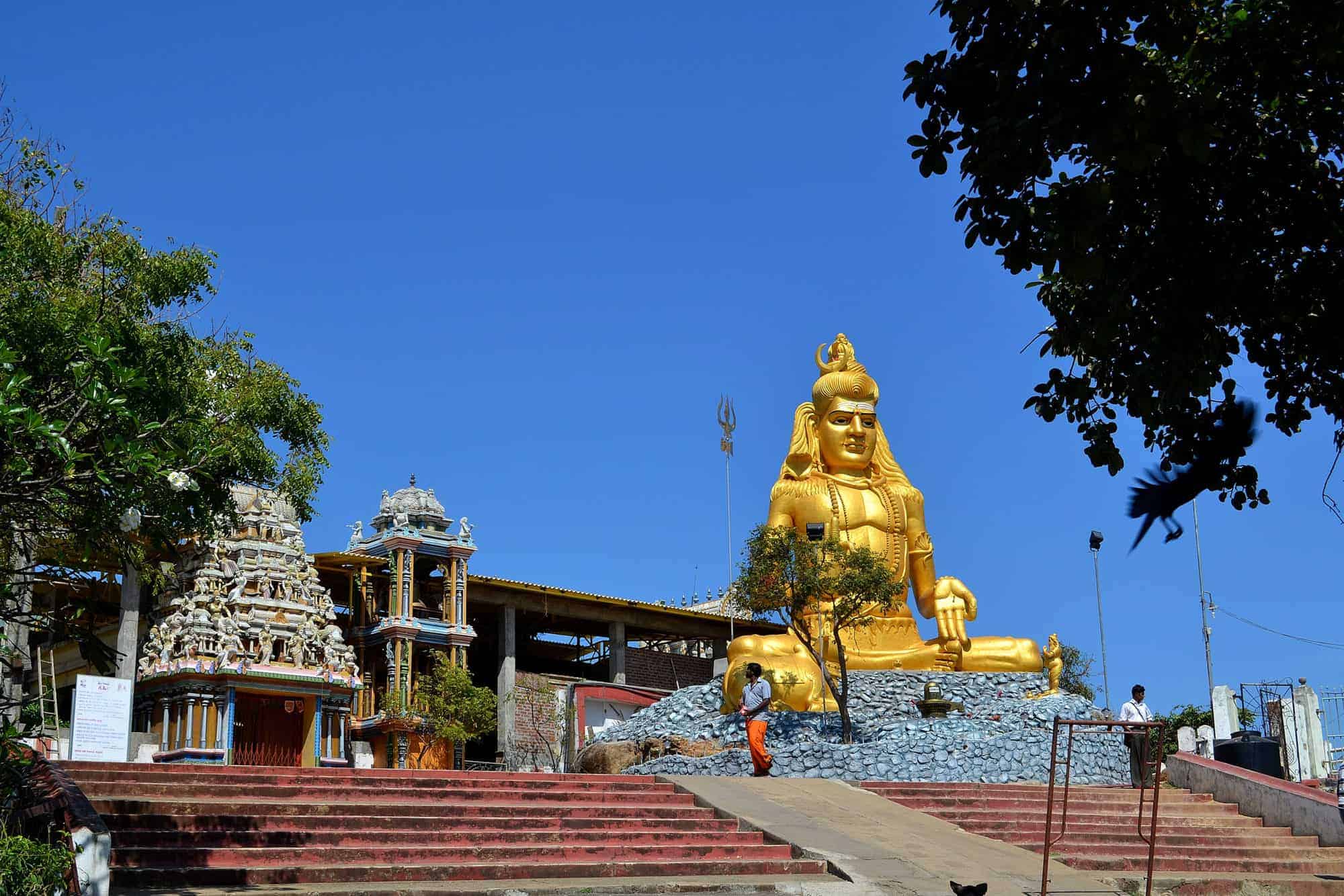
Koneswaram temple of Trincomalee or Thirukonamalai Konesar Temple – The Temple of the Thousand Pillars and Dakshina-Then Kailasam is a classical-medieval Hindu temple complex in Trincomalee, a Hindu religious pilgrimage centre in Eastern Province, Sri Lanka. The most sacred of the Pancha Ishwarams of Sri Lanka, it was built significantly during the reign of the early Cholas and the Five Dravidians of the Early Pandyan Kingdom atop Konesar Malai, a promontory overlooking Trincomalee District, Gokarna bay and the Indian Ocean. Its Pallava, Chola, Pandyan and Jaffna design reflect a continual Tamil Saivite influence in the Vannimai region from the classical period. The monument contains its main shrine to Shiva in the form Kona-Eiswara, shortened to Konesar and is a major place for Hindu pilgrimage, at its height of fame labelled the “Rome of the Gentiles/Pagans of the Orient”. Connected at the mouth of the Mahavilli Ganga River to the footprint of Shiva at Sivan Oli Padam Malai at the river’s source, the temple symbolically crowns the flow of the Ganges River from Shiva’s head of Mount Kailash to his feet.
Read More About Koneswaram Temple / Source
Ranganathaswamy Temple, Srirangam
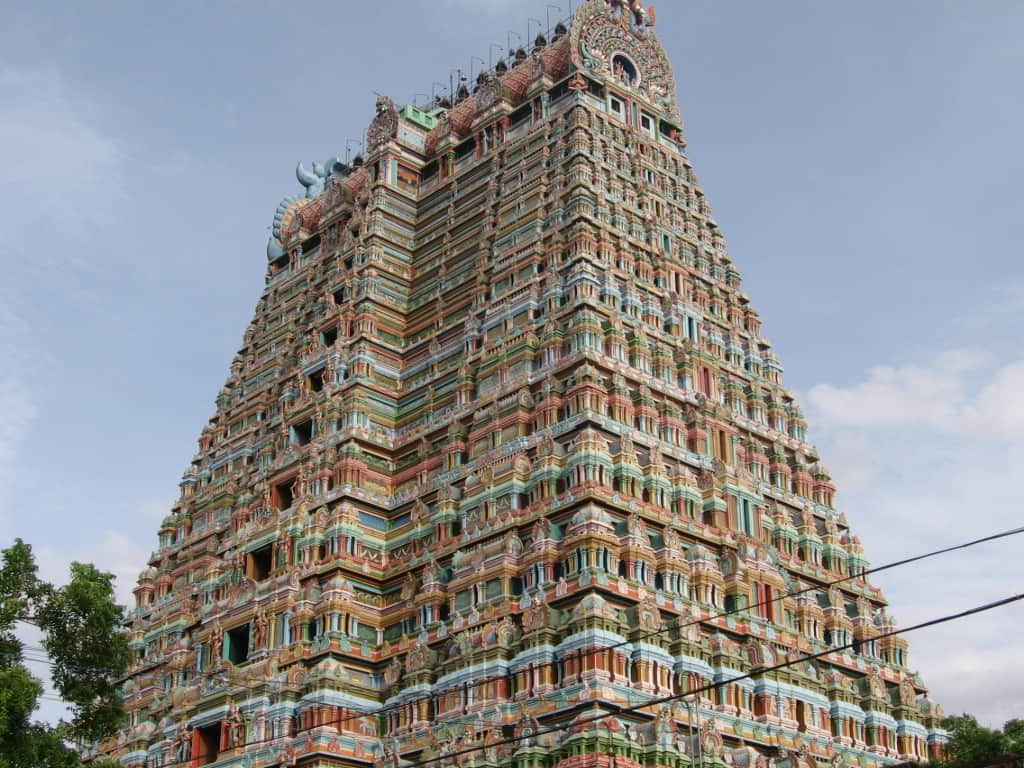
The Sri Ranganathaswamy Temple is a Hindu temple dedicated to Ranganatha, a form of the Supreme God, Maha Vishnu, located in Srirangam, Tiruchirapalli, Tamil Nadu, India. Constructed in the Dravidian architectural style, the temple is glorified by Alvars in their Divya Prabhanda and has the unique distinction of being not only the foremost among the 108 Divya Desams dedicated to Vishnu, but also the largest functioning Hindu temple in the world.The Place Srirangpatna had the name of the Srirangapuri in the early ages later it got the name of the Srirangapatna. The town is an island being surrounded by the river Cauvery. In this town, there is the temple of Sri Ranganatha. Sri Lakshmi Narasimha, Sri Gangadereshwara, Sri Jyothirmaheshwara and other small temples. Among them, the main temple is that of Sri Ranganatha. The inner apartment of SriRanganatha temple was built in 817 CE by a lady by name Hambi, of the class of dancers in the year 894 CE.
It is one of the most illustrious Vaishnava temples in South India rich in legend and history. The temple has played an important role in Vaishnavism history starting with the 11th-century career of Ramanuja and his predecessors Nathamuni and Yamunacharya in Srirangam.
Read More About Ranganathaswamy Temple, Srirangam / Source
Prambanan Temple
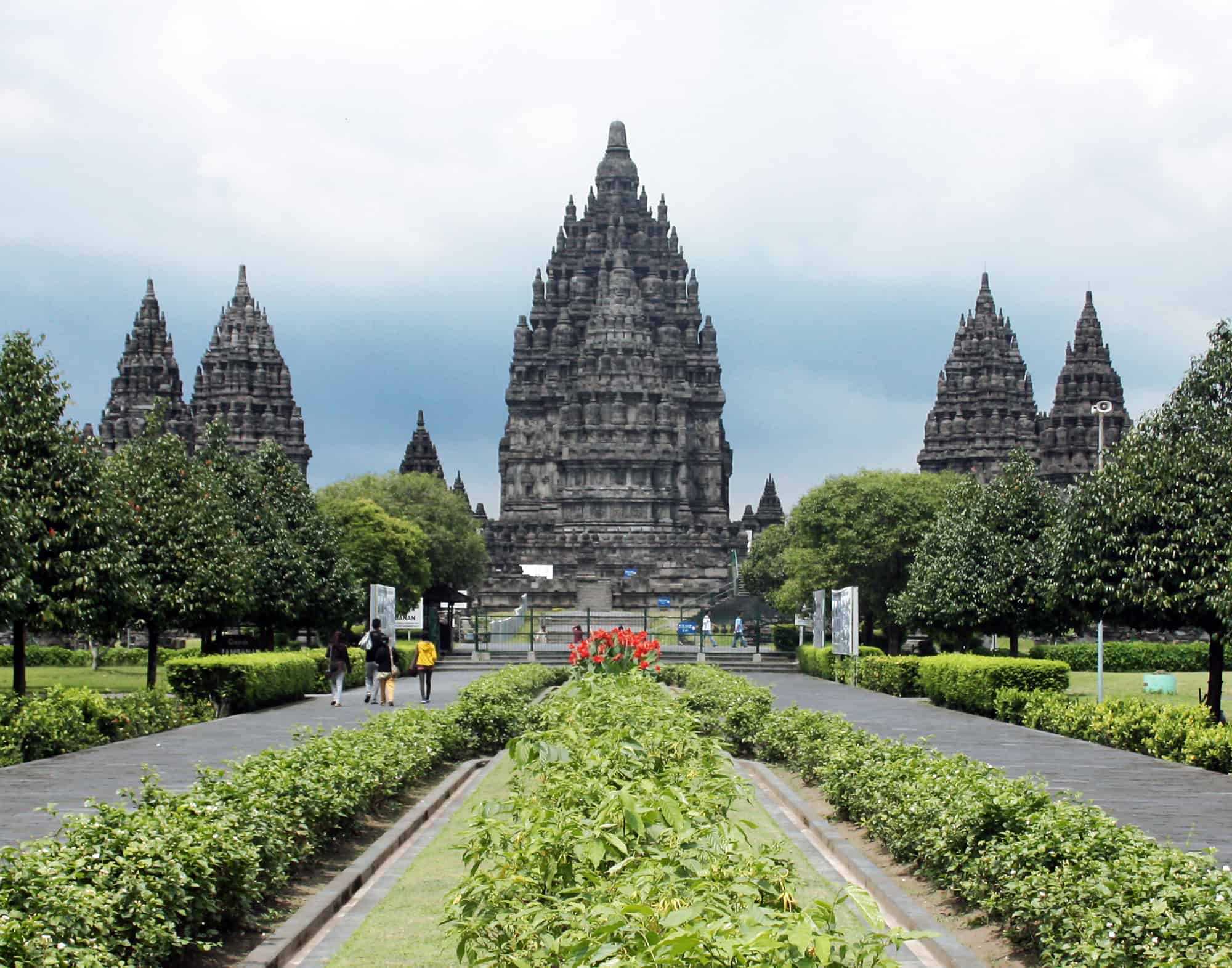
Prambanan or Rara Jonggrang is a 9th-century Hindu temple compound in Special Region of Yogyakarta, Indonesia, dedicated to the Trimūrti, the expression of God as the Creator (Brahma), the Preserver (Vishnu) and the Destroyer (Shiva). The temple compound is located approximately 17 kilometres (11 mi) northeast of the city of Yogyakarta on the boundary between Central Java and Yogyakarta provinces.The temple compound, a UNESCO World Heritage Site, is the largest Hindu temple site in Indonesia and the second-largest in Southeast Asia. It is characterized by its tall and pointed architecture, typical of Hindu architecture, and by the towering 47-metre-high (154 ft) central building inside a large complex of individual temples. Prambanan attracts many visitors from around the world.
Read More About Prambanan Temple / Source
Thillai Nataraja Temple, Chidambaram
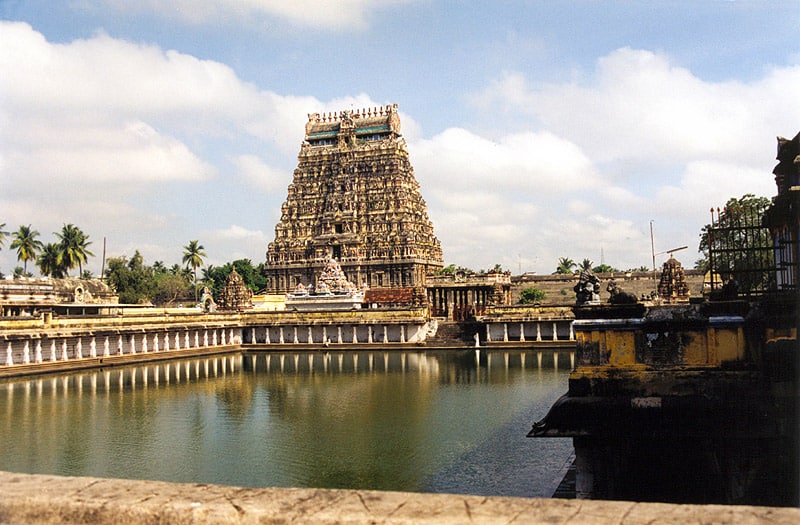
Nataraja Temple, also referred to as the Chidambaram Nataraja temple or Thillai Nataraja temple, is a Hindu temple dedicated to Nataraja – Shiva as the lord of dance – in Chidambaram, Tamil Nadu, India. The temple has mythical roots and a Shiva shrine existed at the site when the town was known as Thillai. Chidambaram, the name of the city and the temple literally means “atmosphere of wisdom” or “clothed in thought”, the temple architecture symbolizes the connection between the arts and spirituality, creative activity and the divine. The temple wall carvings display all the 108 karanas from the Natya Shastra by Bharata Muni, and these postures form a foundation of Bharatanatyam, a classical Indian dance.The present temple was built in the 10th century when Chidambaram was the capital of the Chola dynasty, making it one of the oldest surviving active temple complexes in South India. After its 10th-century consecration by the Cholas who considered Nataraja as their family deity, the temple has been damaged, repaired, renovated and expanded through the 2nd millennium. Most of the temple’s surviving plan, architecture and structure is from the late 12th and early 13th centuries, with later additions in similar style.
Read More About Thillai Nataraja Temple, Chidambaram / Source
Angkor Wat, Cambodia
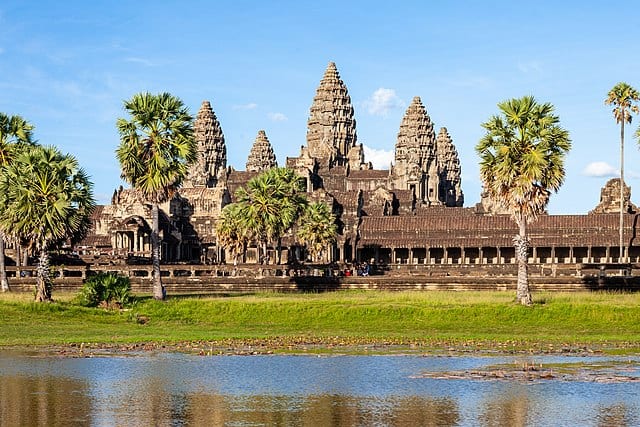
Angkor Wat (; Khmer: អង្គរវត្ត, “City/Capital of Temples”) is a temple complex in Cambodia and the largest religious monument in the world by land area, on a site measuring 162.6 hectares (1.626 km2; 402 acres). Originally constructed as a Hindu temple dedicated to the god Vishnu for the Khmer Empire, it was gradually transformed into a Buddhist temple towards the end of the 12th century, and as such it is also described as a “Hindu-Buddhist” temple. It was built by the Khmer King Suryavarman II in the early 12th century in Yaśodharapura (Khmer: យសោធរបុរៈ, present-day Angkor), the capital of the Khmer Empire, as his state temple and eventual mausoleum. Breaking from the Shaiva tradition of previous kings, Angkor Wat was instead dedicated to Vishnu. As the best-preserved temple at the site, it is the only one to have remained a significant religious centre since its foundation. The temple is at the top of the high classical style of Khmer architecture. It has become a symbol of Cambodia, appearing on its national flag, and it is the country’s prime attraction for visitors.Angkor Wat combines two basic plans of Khmer temple architecture: the temple-mountain and the later galleried temple. It is designed to represent Mount Meru, home of the devas in Hindu mythology: within a moat more than 5 kilometres (3 mi) long and an outer wall 3.6 kilometres (2.2 mi) long are three rectangular galleries, each raised above the next. At the centre of the temple stands a quincunx of towers. Unlike most Angkorian temples, Angkor Wat is oriented to the west; scholars are divided as to the significance of this. The temple is admired for the grandeur and harmony of the architecture, its extensive bas-reliefs, and for the numerous devatas adorning its walls.
Read More About Angkor Wat, Cambodia / Source
BAPS Shri Swaminarayan Mandir
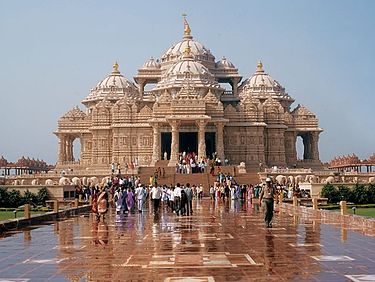
Bochasanwasi Akshar Purushottam Swaminarayan Sanstha (BAPS), is a Hindu denomination within the Swaminarayan Sampradaya. It was formed by Yagnapurushdas (Shastriji Maharaj) on the principle that Swaminarayan was to remain present on earth through a lineage of gurus dating all the way back to Gunatitanand Swami – one of Swaminarayan’s most prominent disciples. Based on the Akshar Purushottam doctrine (also known as Akshar-Purushottam Darshan), followers of BAPS believe Swaminarayan manifests through a lineage of Aksharbrahman Gurus, beginning with Gunatitanand Swami, followed by Bhagatji Maharaj, Shastriji Maharaj, Yogiji Maharaj, Pramukh Swami Maharaj, and presently Mahant Swami Maharaj. As of 2019, BAPS has 44 shikharbaddha mandirs and more than 1,200 mandirs worldwide that facilitate practice of this doctrine by allowing followers to offer devotion to the murtis of Swaminarayan, Gunatitanand Swami, and their successors. BAPS mandirs also feature activities to foster culture and youth development. Many devotees view the mandir as a place for transmission of Hindu values and their incorporation into daily routines, family life, and careers. BAPS also engages in a host of humanitarian and charitable endeavors through BAPS Charities, a separate non-profit aid organization which has spearheaded a number of projects around the world addressing healthcare, education, environmental causes, and community-building campaigns.
Read More About BAPS Shri Swaminarayan Mandir / Source
Thrissur Vadakkunnathan Temple
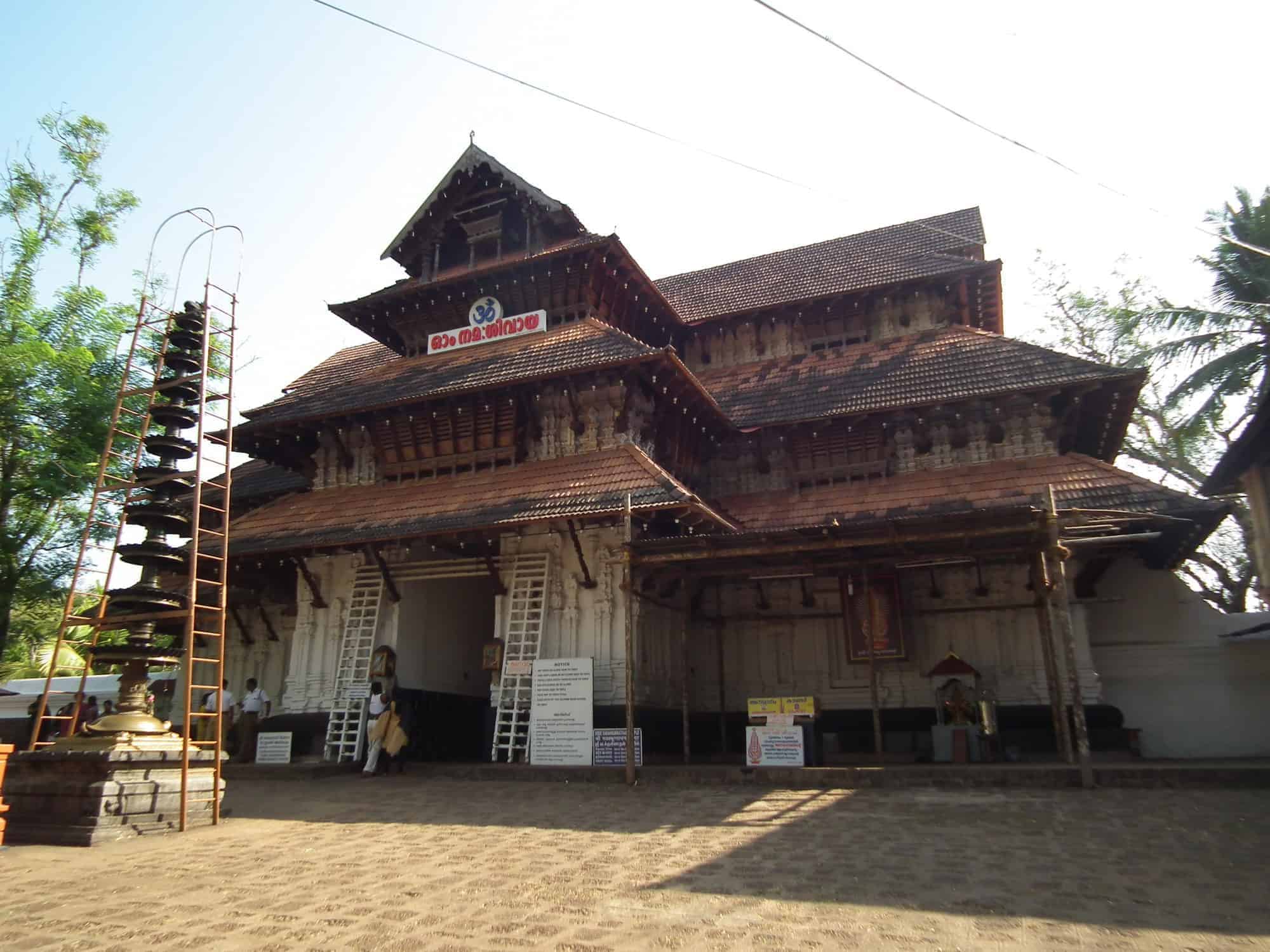
Vadakkumnathan Temple is an ancient Hindu temple dedicated to Shiva at city of Thrissur, of Kerala state in India. This temple is a classical example of the architectural style of Kerala and has one monumental tower on each of the four sides in addition to a kuttambalam. Mural paintings depicting various scenes from the Mahabharata can be seen inside the temple. The shrines and the Kuttambalam display vignettes carved in wood. The temple, along with the mural paintings, has been declared as a National Monument by India under the AMASR Act. According to popular local lore, this is the first temple built by Parasurama, the sixth avatara of Vishnu. Thekkinkadu Maidan, encircling the Vadakkunnathan Temple, is the main venue of the renowned Thrissur Pooram festival.In the year 2012 the Archaeological Survey of India (ASI) has recommended 14 sites, including Vadakkumnathan Temple and palaces, from Kerala to include in the list of UNESCO World Heritage Sites. The temple is also the first one among the 108 Shiva Temples in ancient Kerala, established by Parasurama.
Read More About Thrissur Vadakkunnathan Temple / Source
Ram Janmbhumi

Ram Janmabhoomi (literally, “Rama’s birthplace”) is the name given to the site that is believed to be the birthplace of Rama, the seventh avatar of the Hindu deity Vishnu. The Ramayana states that the location of Rama’s birthplace is on the banks of the Sarayu river in a city called “Ayodhya”.
Some Hindus claim that the exact site of Rama’s birthplace is where the Babri Masjid once stood in the present-day Ayodhya, Uttar Pradesh. According to this theory, the Mughals demolished a Hindu shrine that marked the spot, and constructed a mosque in its place. People opposed to this theory state that such claims arose only in the 18th century, and that there is no evidence for the spot being the birthplace of Rama.
The political, historical and socio-religious debate over the history and location of the Babri Mosque, and whether a previous temple was demolished or modified to create it, is known as the Ayodhya dispute. In 1992, the demolition of the Babri Masjid by Hindu nationalists triggered widespread Hindu-Muslim violence. Several other sites, including places in other parts of India, Afghanistan, and Nepal, have been proposed as birthplaces of Rama.
Read More About Ram Janmbhumi / Source
Rameswaram tample

Ramanathaswamy Temple (Irāmanātasvāmi Kōyil) is a Hindu temple dedicated to the god Shiva located on Rameswaram island in the state of Tamil Nadu, India. It is also one of the twelve Jyotirlinga temples. It is one of the 274 Paadal Petra Sthalams, where the three of the most revered Nayanars (Saivite saints), Appar, Sundarar and Tirugnana Sambandar, have glorified the temple with their songs. The temple was expanded during the 12th century by Pandya Dynasty, and its principal shrines sanctum were renovated by Jeyaveera Cinkaiariyan and his successor Gunaveera Cinkaiariyan of the Jaffna kingdom. The temple has the longest corridor among all Hindu temples in India. The temple is located in Rameswaram considered a holy pilgrimage site for Shaivites, Vaishnavites and Smarthas. The presiding deity, the Lingam of Ramanathaswamy (Shiva), was established and worshiped by Rama before crossing his bridge to Lanka.
Read More About Rameswaram tample / Source
Brahmeswara Temple

Brahmeswara Temple is a Hindu temple dedicated to Shiva located in Bhubaneswar, Odisha, erected at the end of the 9th century CE, is richly carved inside and out. This Hindu temple can be dated with fair accuracy by the use of inscriptions that were originally on the temple. They are now lost, but records of them preserve the information of around 1058 CE. The temple is built in the 18th regnal year of the Somavamsi king Udyotakesari by his mother Kolavati Devi, which corresponds to 1058 CE.
Read More About Brahmeswara Temple / Source
Hindu Temple of Ottawa Carleton (Ottawa)
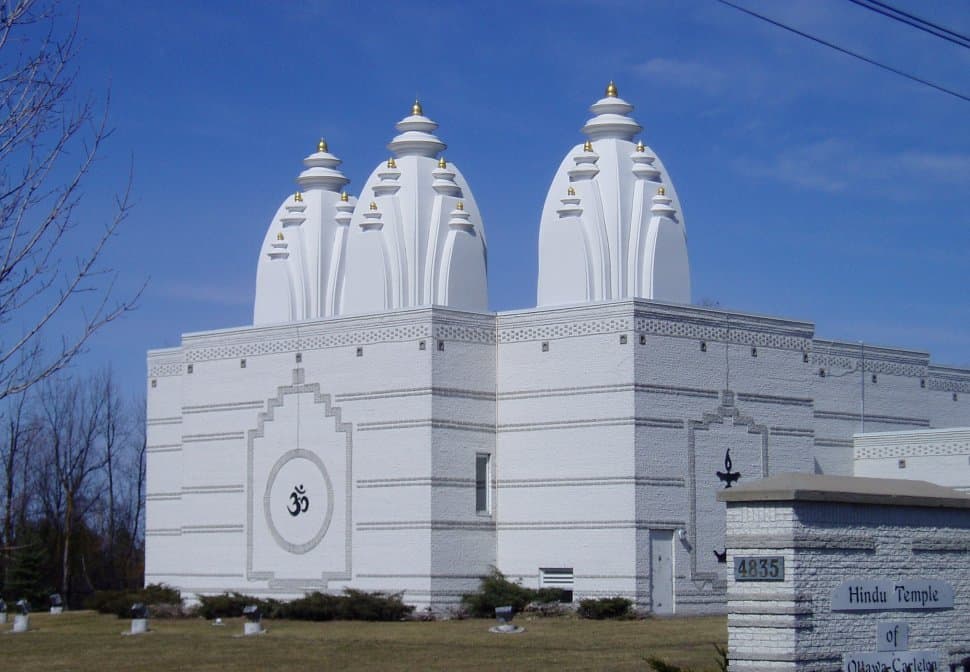
Hindu Temple of Ottawa-Carleton is a significant Hindu temple in the Gloucester section of Ottawa.
For the first time, a Hindu temple in Eastern Ontario in 1985. The temple is located on Bank Street in the rural area to the south of urban Ottawa, south-east of the airport. The site, previously a cornfield, was purchased for the temple in 1984. The $4 million structure, funded by donations made by Canadian Hindus, was officially opened in 1989. It serves the estimated 6,000 Hindus who live in Ottawa, as well as acting as a community and cultural centre for the community with halls, libraries, and other resources. The temple follows traditional Hindu architectural styles, though compromises had to be made to adapt to the cold and weight of snow accumulation. The temple has nine shrines: Ganesha, Kartikeya, Krishna with Radha, Shiva, Lakshmi with Narayana, Rama with Sita and Lakshmana with Hanuman, Durga, Hanuman, and Nataraja.
The effort to build the temple was by Pandit Madhu Sahasrabudhe, a food science researcher who had also served as a priest in the city since 1960. Until his death in 2004 Sahasrabudhe also played an essential role in the community. He is the chair of the Capital Region Interfaith Council. In 2002, he led prayers at a multi-faith thanksgiving event with the Queen in attendance. He frequently appeared as part of the Ottawa Citizen’s panel of local religious leaders.
Read More About Hindu Temple of Ottawa Carleton (Ottawa) / Source
Hindu Temple of Greater Chicago (Lemont)

The Hindu Temple of Greater Chicago (HTGC) is a Hindu temple complex in Lemont, Illinois, established in 1977. The complex includes two separate temples:
Rama Temple, which includes Sri Rama, Sita and Lakshmana, Lord Ganesha, Sri Hanuman, Lord Venkateshwara (Balaji), Mahalakshmi, Sri Krishna, and Radha. Ganesha-Shiva-Durga Temple, which includes, Lord Shiva, Lord Ganesha, Durga Devi, Lord Subrahmanya, Devi Parvathi, Nataraja, Ayappasamy and Navagraha.In addition, there is a separate Spiritual Center, named after Swami Vivekananda. The Swami Vivekanada Spiritual Center, which houses RITU Meditation Center, serves as a venue for many spiritual activities, including meditation, yoga classes, and spiritual lectures.
Adjoining the Vivekananda Spiritual Center, on “Vivekananda Hill”, a hillock in the temple campus, is a 10-foot tall bronze statue of Swami Vivekananda, modeled after his photograph taken in Chicago after his appearance at the World’s Parliament of Religions in 1893. It is the first statue of Vivekananda to be installed in a public place in the United States of America.
Read More About Hindu Temple of Greater Chicago (Lemont) / Source
ISKCON Temple (Banglore)

Sri Radha Krishna-chandra Temple is one of the largest Krishna Hindu temples in the world, affiliated with ISKCON Revival Movement. It is located at Rajajinagar, in North Bangalore in the Indian State of Karnataka. In May 1997, Bangalore ISKCON Temple was inaugurated by the ninth president of India—Shankar Dayal Sharma. Since 1999 it is under control of ISKCON Revival Movement.
Read More About ISKCON Temple (Banglore) / Source
Shri Mayureshwar , Morgaon
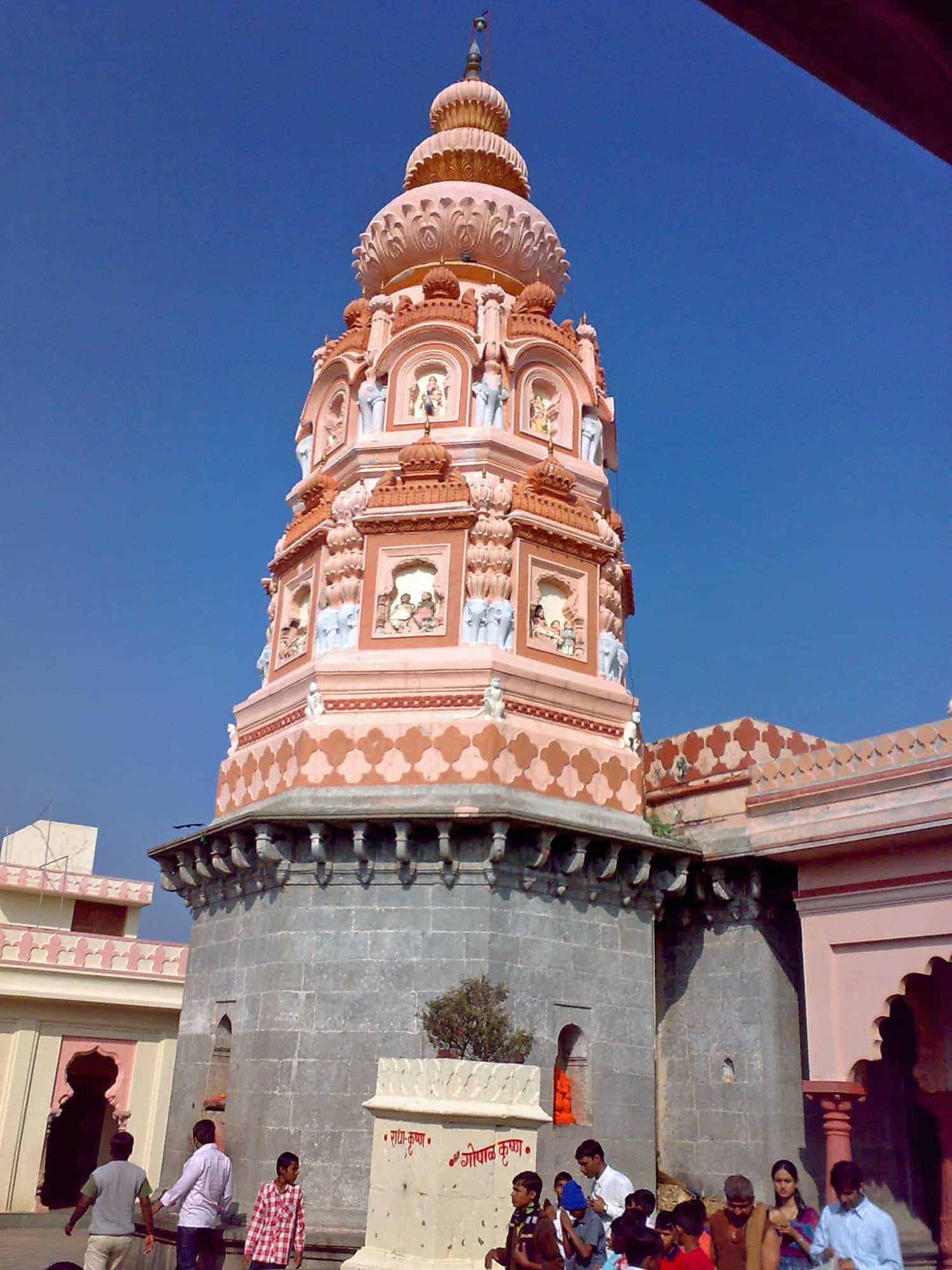
Shri Mayureshwar Mandir or Shri Moreshwar Temple is a Hindu temple (mandir) dedicated to Ganesha, the elephant-headed god of wisdom. It is located in Moragaon in Pune District, about 65 km away from Pune city in the Indian state of Maharashtra. The temple is the starting and ending point of a pilgrimage of eight revered Ganesha temples called Ashtavinayaka.
Moragon is the foremost centre of worship of the Ganapatya sect, which considers Ganesha as the Supreme Being. A Hindu legend relates the temple to killing of the demon Sindhu by Ganesha. The exact date of building of the temple is unknown, though the Ganapatya saint Moraya Gosavi is known to be associated with it. The temple flourished due to the patronage of the Peshwa rulers and descendants of Moraya Gosavi.
Read More About Shri Mayureshwar , Morgaon / Source
Lingaraja temple

Lingaraja Temple is a Hindu temple dedicated to Shiva and is one of the oldest temples in Bhubaneswar, the capital of the Indian state of Odisha. The temple is the most prominent landmark of Bhubaneswar city and one of the major tourist attractions of the state.The Lingaraja temple is the largest temple in Bhubaneswar. The central tower of the temple is 180 ft (55 m) tall. The temple represents the quintessence of the Kalinga architecture and culminating the medieval stages of the architectural tradition at Bhubaneswar. The temple is believed to be built by the kings from the Somavamsi dynasty, with later additions from the Ganga rulers. The temple is built in the Deula style that has four components namely, vimana (structure containing the sanctum), jagamohana (assembly hall), natamandira (festival hall) and bhoga-mandapa (hall of offerings), each increasing in the height to its predecessor. The temple complex has 50 other shrines and is enclosed by a large compound wall.
Bhubaneswar is called the Ekamra Kshetra as the deity of Lingaraja was originally under a mango tree (Ekamra) as noted in Ekamra Purana, a 13th-century Sanskrit treatise. The temple is active in worship practises, unlike most other temples in Bhubaneswar and Shiva is worshipped as Harihara, a combined form of Vishnu and Shiva. The temple has images of Vishnu, possibly because of the rising prominence of Jagannath sect emanating from the Ganga rulers who built the Jagannath Temple in Puri in the 12th century. The central deity of the temple, Lingaraja, is worshipped both as Shiva and Vishnu. The harmony between the two sects of Hinduism, Shaivism, and Vaishnavism, is seen in this temple where the deity is worshipped as Harihara, a combined form of Vishnu and Shiva.
Lingaraja temple is maintained by the Temple Trust Board and the Archaeological Survey of India (ASI). The temple has an average of 6,000 visitors per day and receives lakhs of visitors during festivals. Shivaratri festival is the major festival celebrated in the temple and event during 2012 witnessed 200,000 visitors. The temple compound is not open to non-Hindus, but there is a viewing platform beside the wall offering a good view of the main exteriors. This was originally erected for a visit by Lord Curzon when Viceroy.
Read More About Lingaraja temple / Source
Yamunotri Temple
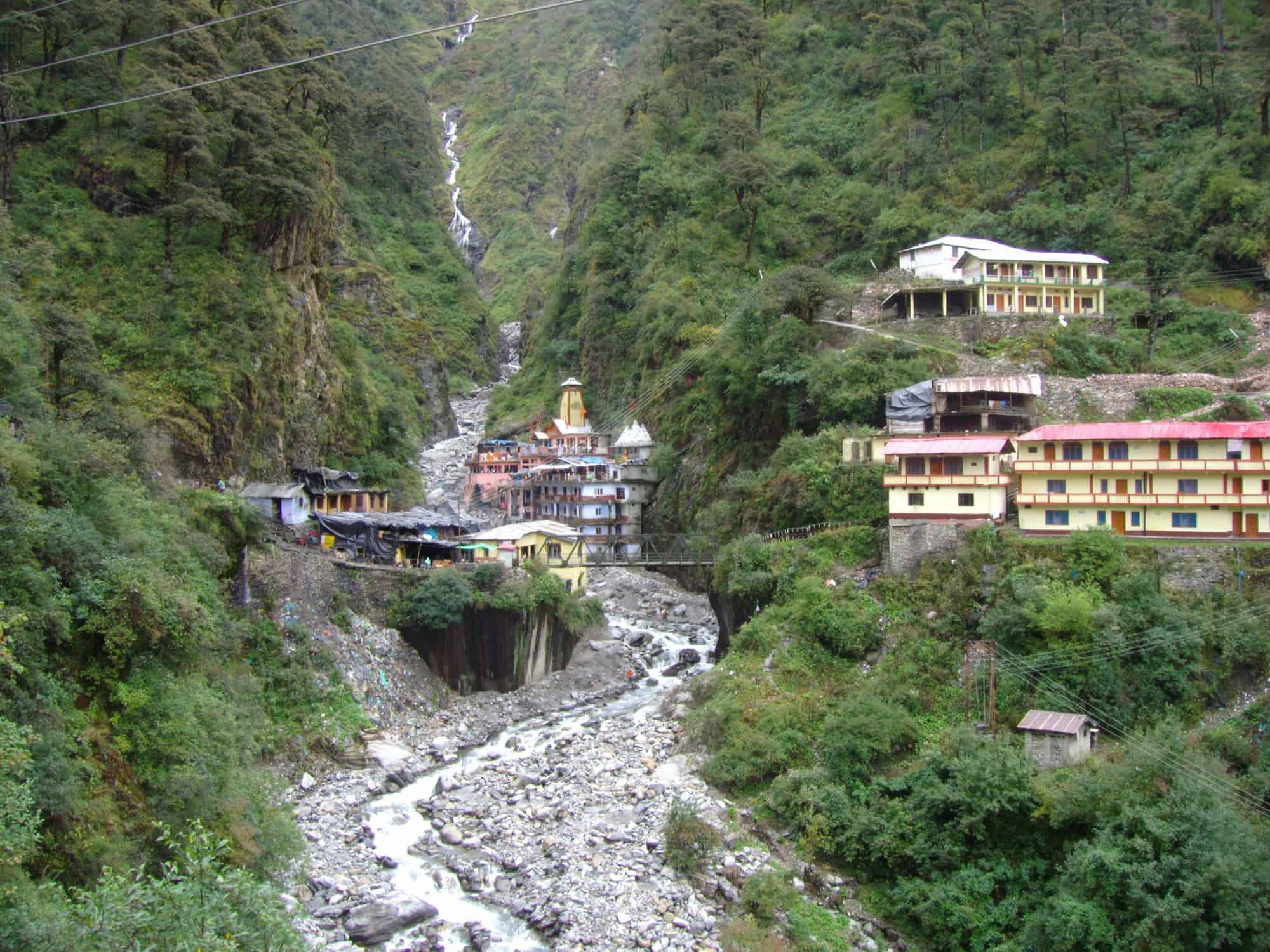
Yamunotri Temple is situated in the western region of Garhwal Himalayas at an altitude of 3,291 metres (10,797 ft) in Uttarkashi district, Uttarakhand. The temple is dedicated to Goddess Yamuna and has a black marble idol of the goddess. The Yamunotri temple is a full day’s journey from Uttarakhand’s main towns — Rishikesh, Haridwar or Dehradun. The actual temple is only accessible by a 13 kilometres (8.1 mi) trek from the town of Hanuman Chatti and a 6 kilometres (3.7 mi) walk from Janki Chatti; horses or palanquins are available for rent. The hike from Hanuman Chatti to Yamunotri takes in views of a number of waterfalls. There are two trekking routes from Hanuman Chatti to Yamunotri, the one along the right bank proceeds via the Markandeya Tirth, where the sage Markandeya wrote the Markandeya Purana, the other route which lies on the left bank of the river goes via Kharsali, from where Yamunotri is a five or six hours climb away.
Read More About Yamunotri Temple / Source
Kailasanathar Temple (Karuppadithattadai)

The Kanchi Kailasanathar temple is the oldest structure in Kanchipuram. Located in Tamil Nadu, India, it is a Hindu temple in the Tamil architectural style. It is dedicated to the Lord Shiva, and is known for its historical importance. The temple was built from 685-705 AD by a Rajasimha (Narasimhavarman II) ruler of the Pallava Dynasty. The low-slung sandstone compound contains a large number of carvings, including many half-animal deities which were popular during the early Pallava architectural period. The structure contains 58 small shrines which are dedicated to various forms of Shiva. These are built into niches on the inner face of the high compound wall of the circumambulatory passage. The temple is one of the most prominent tourist attractions of the city.
Read More About Kailasanathar Temple (Karuppadithattadai) / Source
Mahakaleshwar Jyotirlinga (Ujjain)
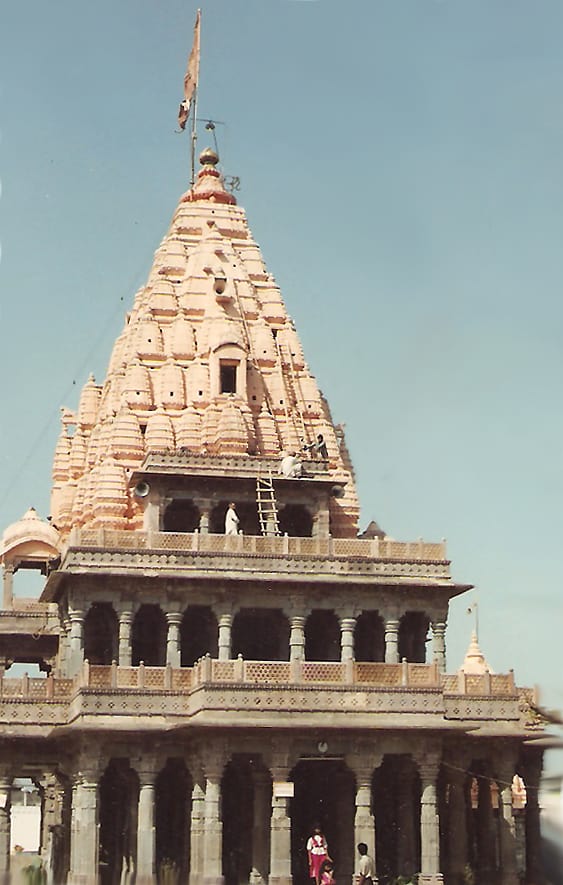
Mahakaleshwar Jyotirlinga is a Hindu temple dedicated to Lord Shiva and is one of the twelve Jyotirlingams, shrines which are said to be the most sacred abodes of Lord Shiva. It is located in the ancient city of Ujjain in the state of Madhya Pradesh, India. The temple is situated on the side of the holy river KShipra. The presiding deity, Lord Shiva in the lingam form is believed to be Swayambhu, deriving currents of power (Shakti) from within itself as against the other images and lingams that are ritually established and invested with mantra-shakti.
On 5 September 2019, A show premiered on History TV18 Mahakaleshwar : The Legends of Shiva showed about the working in Mahakaleshwar Mandir during the Shivaratri.
Read More About Mahakaleshwar Jyotirlinga (Ujjain) / Source
Nellaiappar Temple

Nellaiappar Temple is a Hindu temple dedicated to the deity Shiva, located in Tirunelveli, a city in the South Indian state of Tamil Nadu. Shiva is worshipped as Nellaiappar (also called Venuvananathar) represented by the lingam and his consort Parvati is depicted as Kanthimathi Amman. The temple is located on the northern banks of Thamirabarani River in Tirunelveli district. The presiding deity is revered in the 7th century Tamil Saiva canonical work, the Tevaram, written by Tamil saint poets known as the nayanmars and classified as Paadal Petra Sthalam.
The temple complex covers an area of fourteen and a half acres and all its shrines are enclosed with concentric rectangular walls. The temple has a number of shrines, with those of Swamy Nellaiappar and his consort Sri Kanthimathi Ambal being the most prominent.
Read More About Nellaiappar Temple / Source
Padmanabhaswamy Temple (Thiruvananthapuram)

The Padmanabhaswamy temple is a Hindu temple located in Thiruvananthapuram, the state capital of Kerala, India. The name of the city of Thiruvananthapuram in Malayalam translates to “The City of Lord Ananta”, referring to the deity of the Padmanabhaswamy temple. The temple is built in an intricate fusion of the Chera style and the Dravidian style of architecture, featuring high walls, and a 16th-century gopura. While the Ananthapura temple in Kumbla is considered the original seat of the deity (“Moolasthanam”), architecturally to some extent, the temple is a replica of the Adikesava Perumal temple in Thiruvattar.The principal deity Padmanabhaswamy (Vishnu) is enshrined in the “Anantha Shayana” posture, the eternal yogic sleep on the serpent Adi Shesha. Padmanabhaswamy is the tutelary deity of the royal family of Travancore. The titular Maharaja of Travancore, Moolam Thirunal Rama Varma, is the trustee of the temple.
Read More About Padmanabhaswamy Temple (Thiruvananthapuram) / Source
Shri Ekambareswarar Temple (Kanchipuram)

Ekambareswarar Temple (Ekambaranathar Temple) is a Hindu temple dedicated to the deity Shiva, located in the town of Kanchipuram in Tamil Nadu, India. It is significant to the Hindu sect of Saivism as one of the temples associated with the five elements, the Pancha Bhoota Stalas, and specifically the element of earth, or Prithvi. Shiva is worshiped as Ekambareswarar or Ekambaranathar, and is represented by the lingam, with his idol referred to as Prithvi lingam. His consort Parvati is depicted as Elavarkuzhali. The presiding deity is revered in the 7th century Tamil Saiva canonical work, the Tevaram, written by Tamil saint poets known as the nayanars and classified as Paadal Petra Sthalam. The temple also houses Nilathingal Thundam Perumal temple, a Divyadesam, the 108 temples revered in the Vaishnava canon Nalayira Divya Prabhandam.The temple complex covers 25 acres, and is one of the largest in India. It houses four gateway towers known as gopurams. The tallest is the southern tower, with 11 stories and a height of 58.5216 metres (192 ft), making it one of the tallest temple towers in India. The temple has numerous shrines, with those of Ekambareswarar and Nilathingal Thundam Perumal being the most prominent. The temple complex houses many halls; the most notable is the thousand-pillared hall built during the Vijayanagar period.
Read More About Shri Ekambareswarar Temple (Kanchipuram) / Source
Pashupatinath Temple (Kathmandu)

The Pashupatinath Temple is a famous and sacred Hindu temple complex that is located on the banks of the Bagmati River, approximately 5 km north-east of Kathmandu in the eastern part of Kathmandu Valley, the capital of Nepal. The temple serves as the seat of Pashupatinath. This temple complex
was inscribed on the UNESCO World Heritage Sites’s list in 1979. This “extensive Hindu temple precinct” is a “sprawling collection of temples, ashrams, images and inscriptions raised over the centuries along the banks of the sacred Bagmati river” and is included as one of the seven monument groups in UNESCO’s designation of Kathmandu Valley.The temple is one of the 275 Tamil Paadal Petra Sthalams (Holy Abodes of Shiva) on the continent. Kotirudra Samhita, Chapter 11 on the Shivalingas of the North, in Shiva Purana mentions this Shivalinga as the bestower of all wishes.
Read More About Pashupatinath Temple (Kathmandu) / Source
Sri Mariamman Temple (Singapore)

The Sri Mariamman Temple is Singapore’s oldest Hindu temple. It is an agamic temple, built in the Dravidian style. Located at 244 South Bridge Road, in the downtown Chinatown district, the temple serves the majority Hindu Singaporeans, Tamilians, in the city-state. Due to its architectural and historical significance, the temple has been gazetted a National Monument and is a major tourist attraction. Sri Mariamman Temple is managed by the Hindu Endowments Board, a statutory board under the Ministry of Community Development, Youth and Sports.
The Sri Mariamman Temple was founded in 1827 by Naraina Pillai, eight years after the East India Company established a trading settlement in Singapore. Pillai was a government clerk from Penang who arrived in Singapore with Sir Stamford Raffles on his second visit to the island in May 1819. Pillai went on to set up the island’s first construction company, and also entered the textile trade. He rapidly established himself in business and was identified as a leader of the Indian community.
Read More About Sri Mariamman Temple (Singapore) / Source
Sri Munneswaram Temple

Munneswaram temple is an important regional Hindu temple complex in Sri Lanka. It has been in existence at least since 1000 CE although myths surrounding the temple associate it with the popular Indian epic Ramayana, and its legendary hero-king Rama. The temple is one of the ancient Pancha Ishwarams dedicated to Shiva in the region.
The temple complex is a collection of five temples, including a Buddhist temple. The central temple dedicated to Shiva (Siva) is the most prestigious and biggest, and is popular amongst Hindus. The other temples are dedicated to Ganesha, Ayyanayake and Kali. The Kali temple is also popular with Buddhists, who frequent the complex. Post-19th century, most of the devotees of all temples in the complex belong to the majority Sinhala Buddhist ethnic group; the temples, excluding the Ayyanayake and the Buddhist temple, are administered by families belonging to the minority Hindu Tamils.
The temple is located in Munneswaram, a village with mixed Sinhala and Tamil population situated in the historic Demala Pattuva (“Tamil division”) region in the Puttalam District. The main Shiva temple owns extensive property in the surrounding villages, ownership of which was affirmed when the region was part of the medieval Kotte Kingdom. The temple was destroyed twice by the Portuguese colonial officers, who handed over the properties to the Jesuits.
Read More About Sri Munneswaram Temple / Source
Vraj Temple
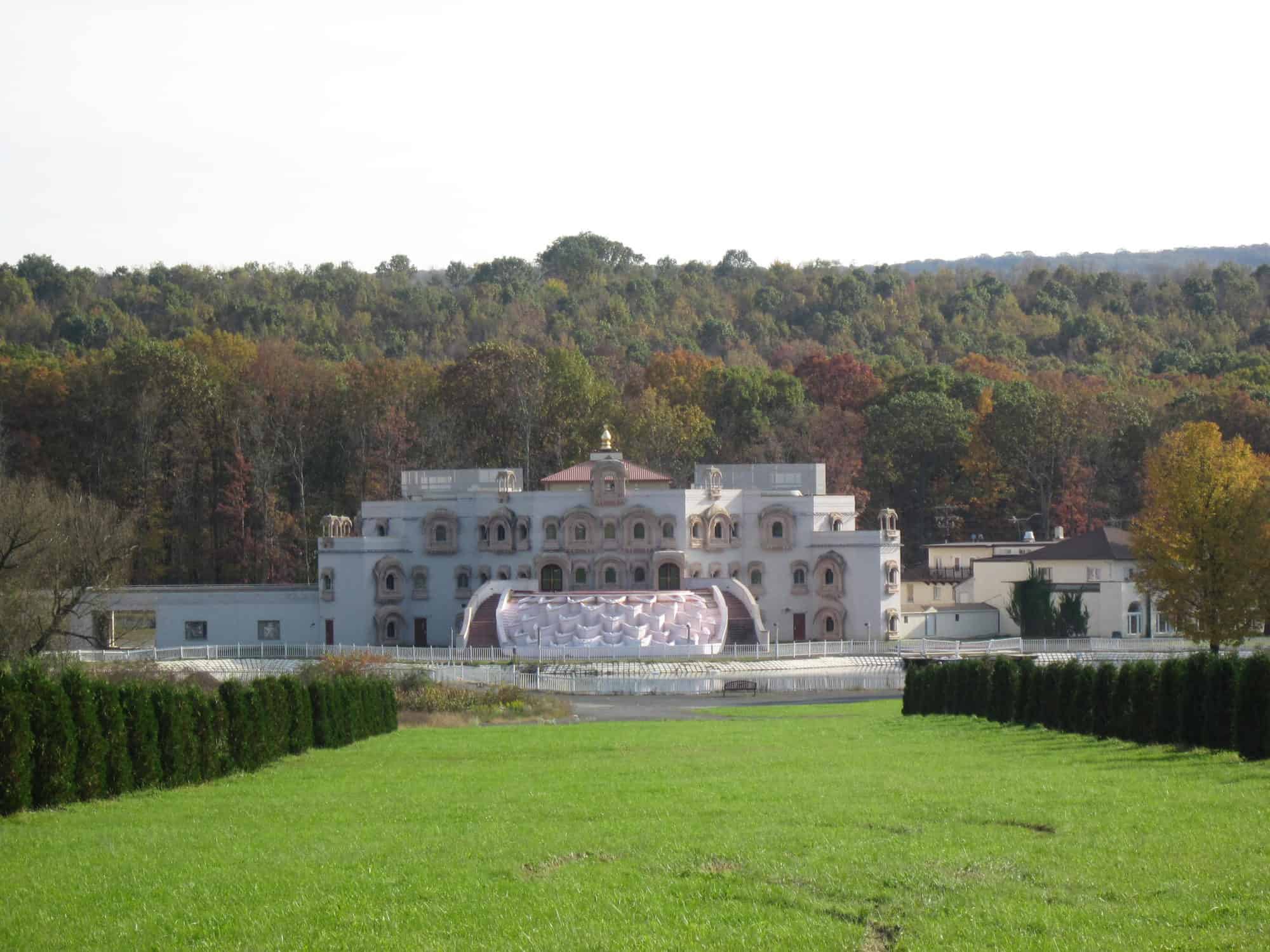
The Vraj Hindu Temple is located in Schuylkill County, in Eastern Pennsylvania, United States, two miles west of the intersection of Routes 183 and 895. It is a multimillion-dollar temple or haveli covering 300 acres (1.2 km2) of the land. Vraj is also known as Noontan Nadalaya, and abode for God Shrinathji (a manifestation of Krishna). It is visited by an average of 100,000 Hindu pilgrims per year. Vraj offers daily prayers (Darshans), annual events and volunteer opportunities for young people.
Read More About Vraj Temple / Source
Annamalaiyar Temple
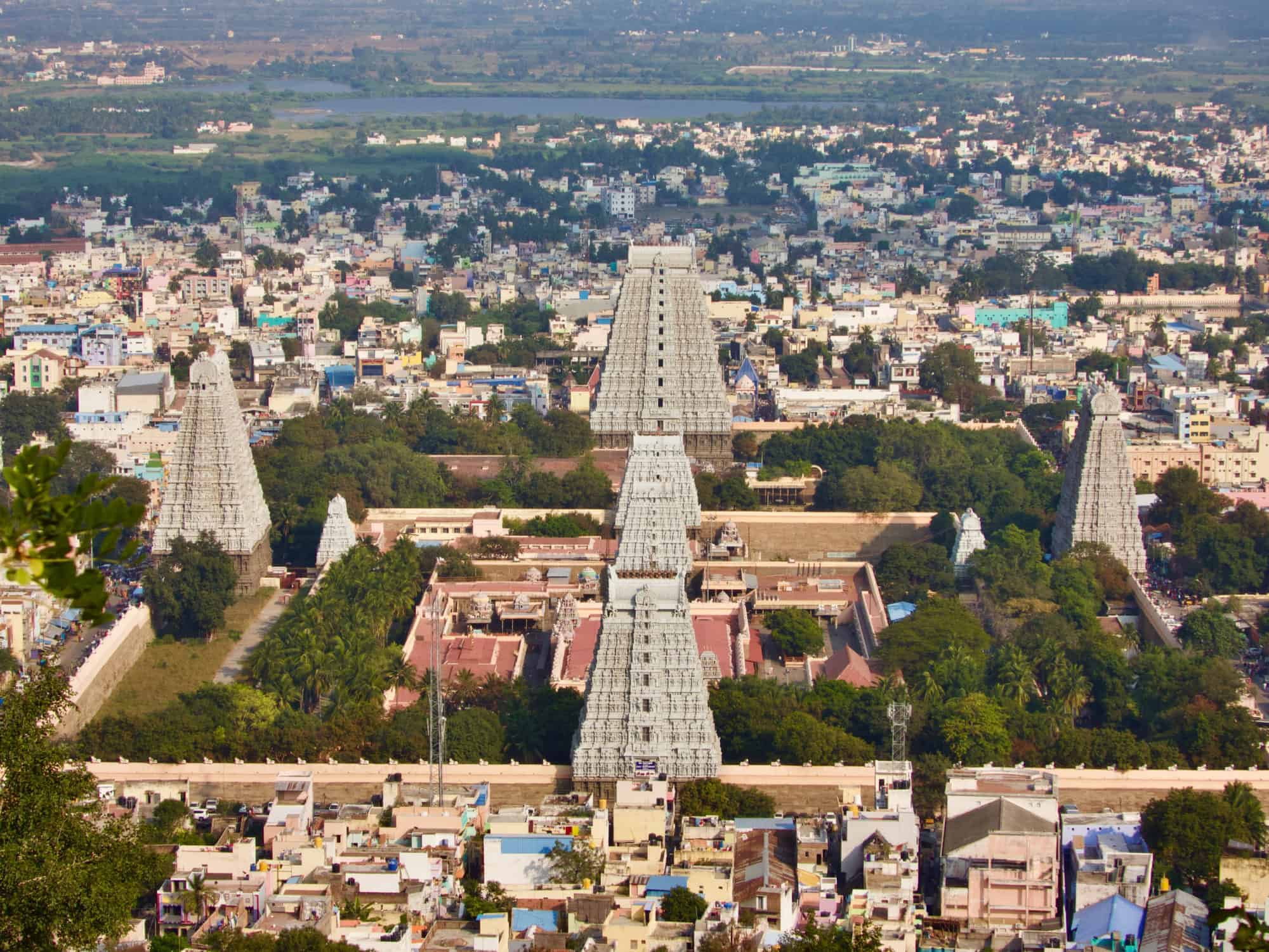
Arunachalesvara Temple (also called Annamalaiyar Temple), is a Hindu temple dedicated to the deity Shiva, located at the base of Arunachala hill in the town of Thiruvannamalai in Tamil Nadu, India. It is significant to the Hindu sect of Saivism as one of the temples associated with the five elements, the Pancha Bhoota Stalas, and specifically the element of fire, or Agni.
Shiva is worshiped as Arunachalesvara or Annamalaiyar, and is represented by the lingam, with his idol referred to as Agni lingam. His consort Parvati is depicted as Unnamalai Amman. The presiding deity is revered in the 7th century Tamil Saiva canonical work, the Tevaram, written by Tamil saint poets known as the nayanars and classified as Paadal Petra Sthalam. The 9th century Saiva saint poet Manikkavasagar composed the Tiruvempaavai here.
The temple complex covers 10 hectares, and is one of the largest in India. It houses four gateway towers known as gopurams. The tallest is the eastern tower, with 11 stories and a height of 66 metres (217 ft), making it one of the tallest temple towers in India built by sevappa nayakkar (Nayakar dynasty) The temple has numerous shrines, with those of Arunachalesvara and Unnamalai Amman being the most prominent. The temple complex houses many halls; the most notable is the thousand-pillared hall built during the Vijayanagar period.
Read More About Annamalaiyar Temple / Source
Sri Laxmi Narayan Mandir (Birla Mandir)
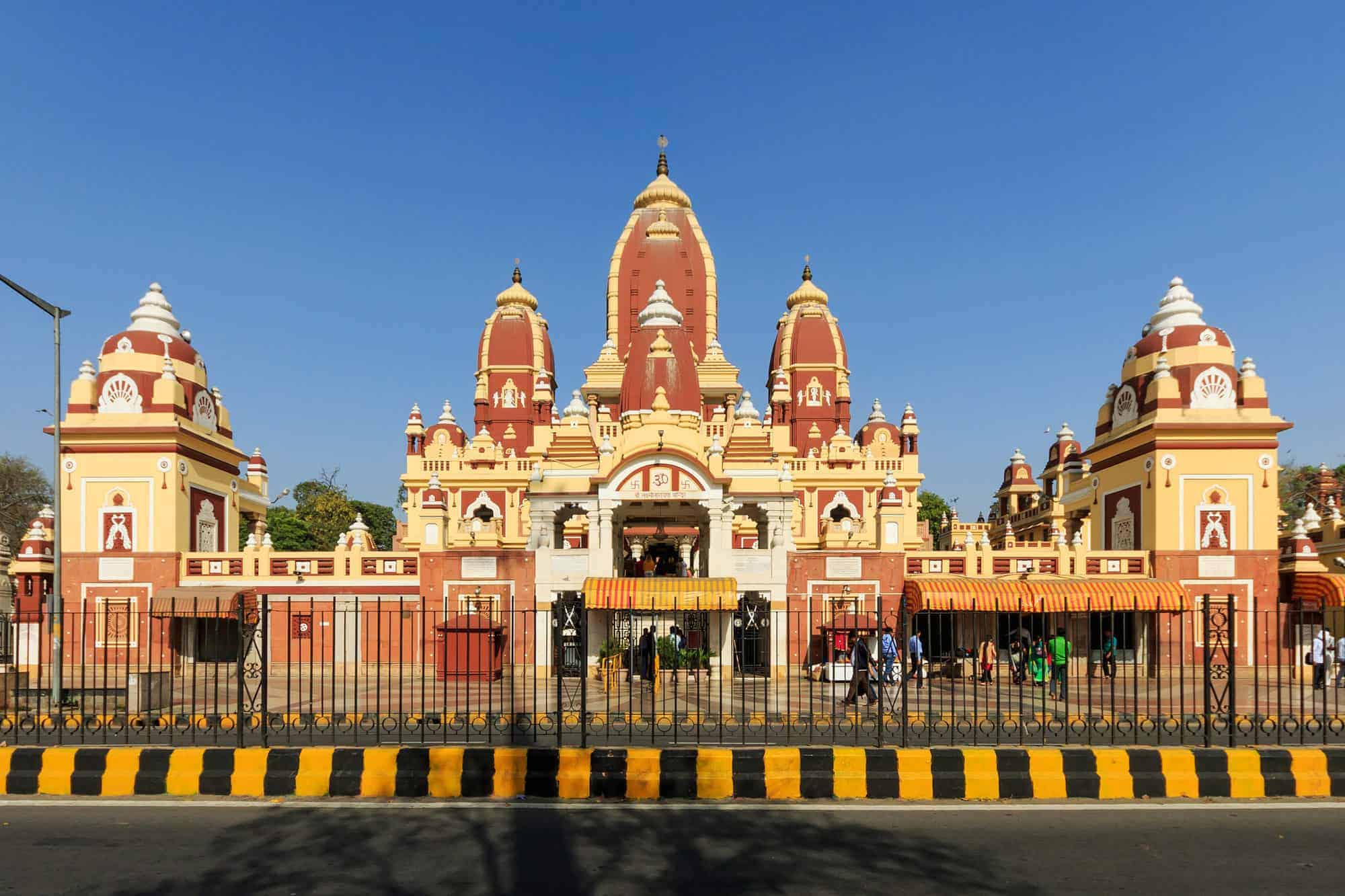
The Laxminarayan Temple, also known as the Birla Mandir is a Hindu temple up to large extent dedicated to Laxminarayan in Delhi, India. Laxminarayan usually refers to Vishnu, Preserver in the Trimurti, also known as Narayan, when he is with his consort Lakshmi. The temple, inaugurated by Mahatma Gandhi, was built by Jugal Kishore Birla from 1933 and 1939. The side temples are dedicated to Shiva, Krishna and Buddha.It was the first large Hindu temple built in Delhi. The temple is spread over 7.5 acres, adorned with many shrines, fountains, and a large garden with Hindu and Nationalistic sculptures, and also houses Geeta Bhawan for discourses. The temple is one of the major attractions of Delhi and attracts thousands of devotees on the festivals of Janmashtami and Diwali.
Read More About Sri Laxmi Narayan Mandir (Birla Mandir) / Source
Thyagaraja Temple
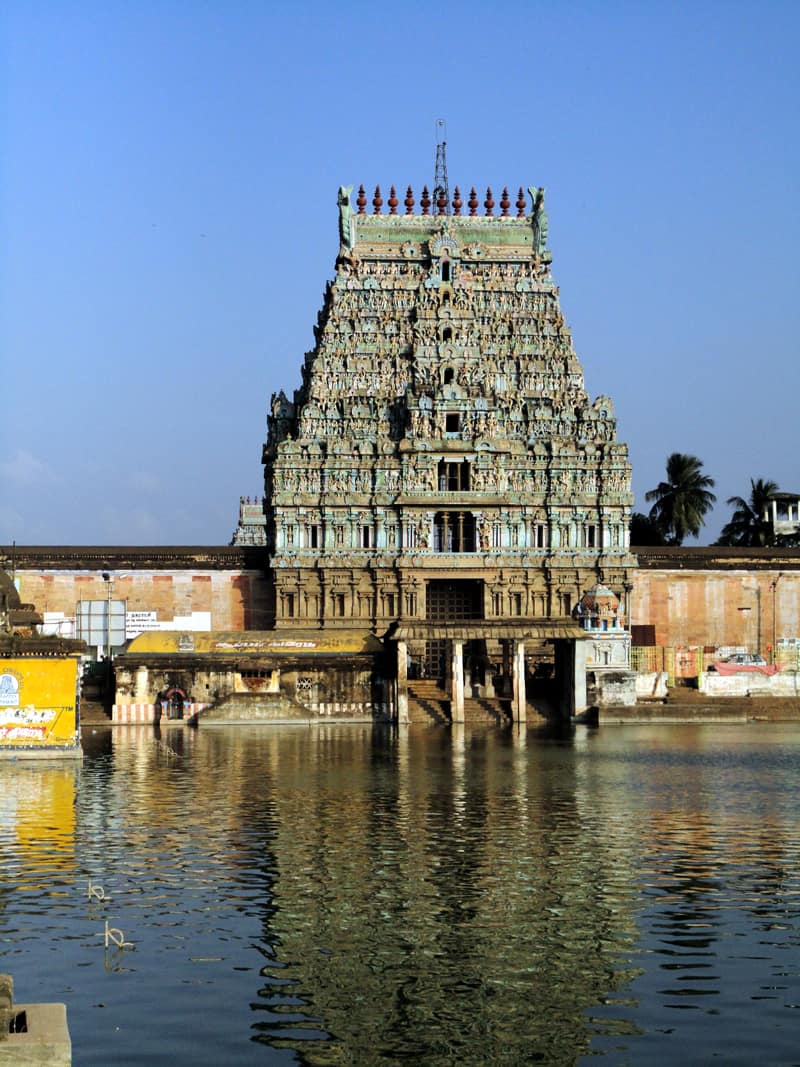
Thyagaraja Temple is a Shiva temple, located in the town of Thiruvarur in Tamil Nadu, India. Shiva is worshiped as Vanmiganathar, and is represented by the lingam. Daily poojas are offered to his idol referred to as Maragatha lingam. The main idol of worship is Lord Thiyagarajar, depicted as a Somaskanda form.His consort Parvathi is depicted as Kondi. The presiding deity is revered in the 7th century Saiva canonical work, the Tevaram, written in Tamil by saint poets known as the nayanars and classified as Paadal Petra Sthalam.
The temple complex covers 30 acres, and is one of the largest in India. It houses nine gateway towers known as gopurams. The tallest is the eastern tower, with four stories and a height of 30 metres (98 ft). The temple has numerous shrines, with those of Thyagaragar (Veethi Vidangar) and Neelothbalambal (Alliyankothai) being the most prominent.
Read More About Thyagaraja Temple / Source
Vaitheeswaran Koil
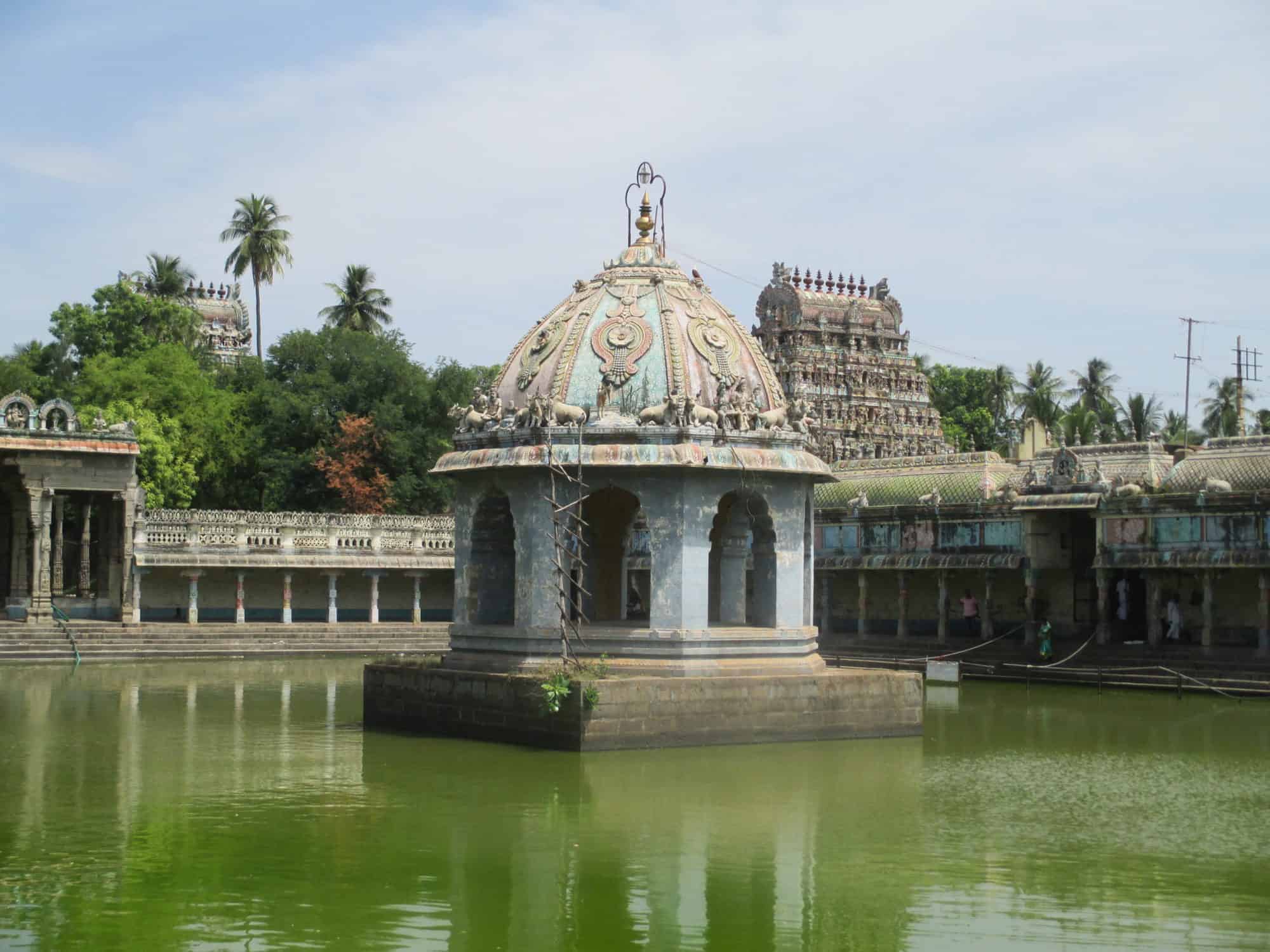
Vaitheeswaran Kovil is a Hindu temple dedicated to the Shiva, located in the Indian state of Tamil Nadu. Shiva is worshipped as Vaidyanathar or Vaitheeswaran meaning the “God of healing” and it is believed that prayers to Vaitheeswaran can cure diseases. Vaitheeswaran is a Tamil derivative from vaidya (Doctor) and Ishvara (God/Master). The presiding deity is Sri vaidyanathan, facing towards West whereas East side is the common one. He is the God of Healing. When pronouncing in Tamil, it sounds like “vaideeswaran”. It is one of the nine Navagraha (nine planets) temples and is associated with the planet Mars (Angaraka).
The village is also known for palm leaf astrology called Naadi astrology in Tamil. It is located 7 kilometers from Sirkazhi, 235 kilometers from Chennai, 27 km from Chidambaram, 110 km from Thanjavur and 16 km from Mayiladuthurai.
The holy waters of the Siddhamirtham tank within the temple complex contains nectar, and a holy dip is believed to cure all diseases.The temple is revered by the Tevaram hymns of 7th-century Saiva nayanars – Tamil saint poets and is also classified as a Paadal Petra Sthalam (temple revered by the nayanars).
Read More About Vaitheeswaran Koil / Source
Amarnath Cave Temple

Amarnath cave is a Hindu shrine located in Jammu and Kashmir, India. The cave is situated at an altitude of 3,888 m (12,756 ft), about 141 km (88 mi) from
Srinagar, the summer capital of Jammu and Kashmir and reached through Pahalgam town. The shrine forms an important part of Hinduism, and is considered to be one of the holiest shrines in Hinduism. The cave is surrounded by snowy mountains. The cave itself is covered with snow most of the year except for a short period of time in summer when it is open for pilgrims. Hundreds of thousands of Hindu and other devotees make an annual pilgrimage to the Amarnath cave across challenging mountainous terrain.
The Amarnath temple is one of the 51 Shakti Peethas, temples throughout South Asia that commemorate the location of fallen body parts of the Hindu deity Sati.
Read More About Amarnath Cave Temple / Source
Gangotri Mandir
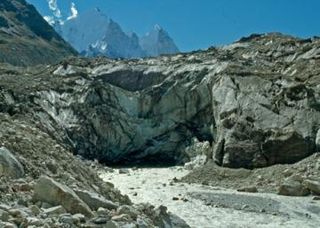
Gangotri is a town anda a Nagar Panchayat (municipality) in Uttarkashi district in the state of Uttarakhand, India. It is a Hindu pilgrim town on the banks of the river Bhagirathi and origin of river Ganges. It is on the Greater Himalayan Range, at a height of 3,100 metres (10,200 ft). According to popular Hindu legend, it was here that Goddess Ganga descended when Lord Shiva released the mighty river from the locks of his hair.
Read More About Gangotri Mandir / Source
Dwarkadhish Temple
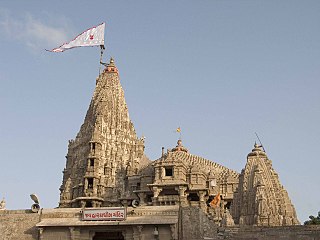
The Dwarkadhish temple, also known as the Jagat Mandir and occasionally spelled Dwarakadheesh, is a Hindu temple dedicated to god Krishna, who is worshiped here by the name Dwarkadhish, or ‘King of Dwarka’. The temple is located at Dwarka, Gujarat, India, one of the destinations of Char Dham, a Hindu pilgrimage circuit. The main shrine of the five storied building, supported by 72 pillars, is known as Jagat Mandir or Nija Mandir, archaeological findings suggest it to be 2,000 – 2,200 years old. The temple was enlarged in the 15th- 16th century. The Dwarkadhish Temple is a Pushtimarg temple, hence it follows the guidelines and rituals created by Vallabhacharya and Vitheleshnath.According to tradition, the original temple was believed to have been built by Krishna’s grandson, Vajranabha, over the hari-griha (Krishna’s residential place). The original structure was destroyed by Mahmud Begada in 1472, and subsequently rebuilt in the 15th-16th century. The temple became part of the Char Dham pilgrimage considered sacred by Hindus in India. Adi Shankaracharya, the 8th century Hindu theologian and philosopher, visited the shrine. The other three being comprising Rameswaram, Badrinath and Puri.
Read More About Dwarkadhish Temple / Source
Shri Venkateswara Balaji Temple - England
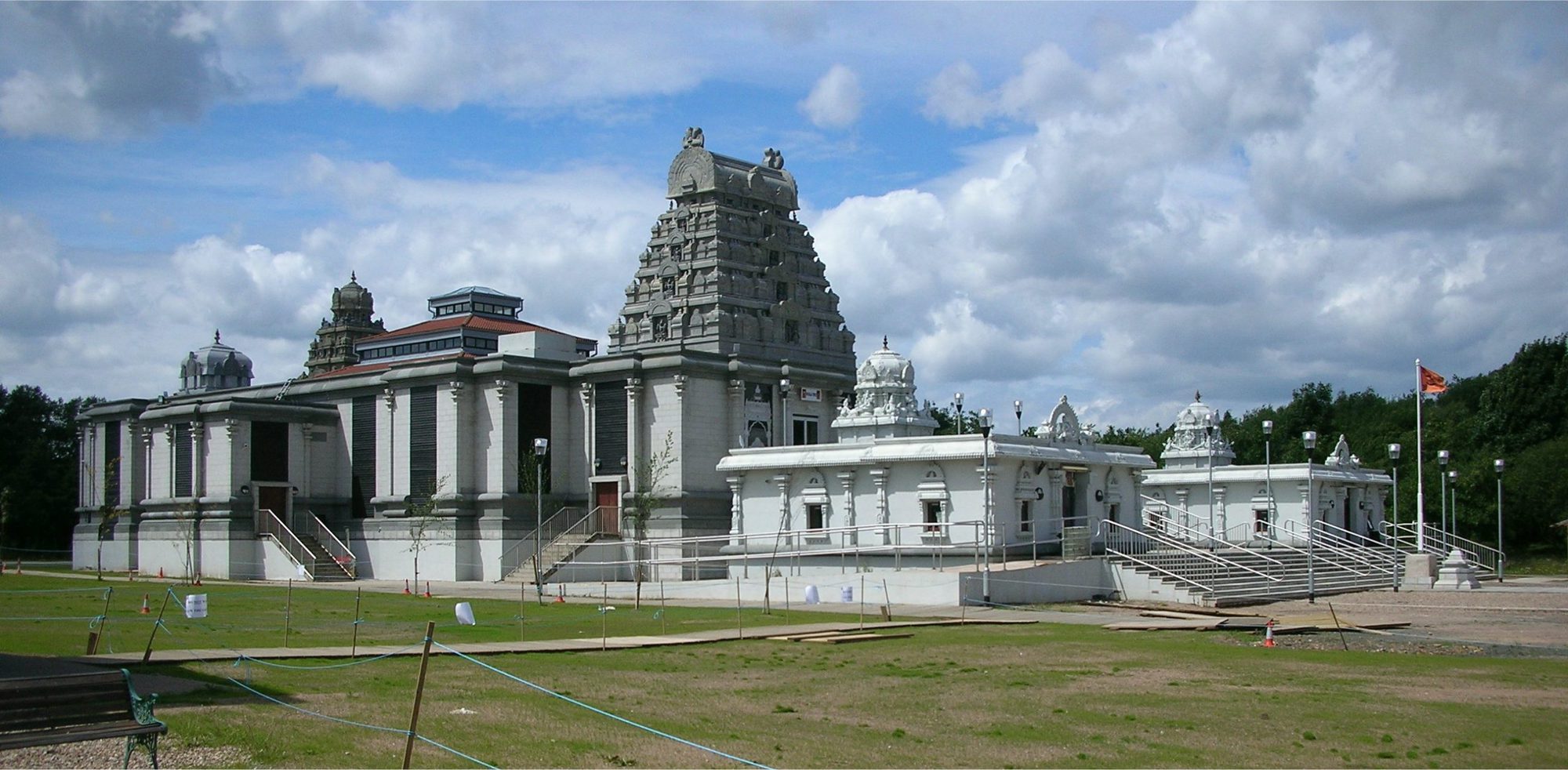
The Shri Venkateswara (Balaji) Temple (grid reference SO980906) is one of the largest functioning Hindu temples in Europe. It is dedicated in the Vaishnava tradition to a form of the Hindu god Vishnu. The temple is located in Tividale, West Midlands, England between the suburbs of Tipton and Oldbury, northwest of Birmingham city. The temple was designed with inspiration from the Tirupati Venkateswara Temple in Andhra Pradesh, India. The temple was consecrated and opened to the general public in August 2006.The primary deity worshiped at this temple is Venkateswara, a well known manifestation of Vishnu. Within the main temple complex are also shrines to his consort Padmavati(Alamelu). The temple also houses shrines to other major Hindu deities Hanuman, Shiva, Karthikeya, Ganesh, Ayappan and the Navagraha.The temple runs the Balaji School for Culture & Education which provides spiritual and cultural foundation for children and arranges classes on Veda (Hindu scriptures), music etc. The temple has a large Community Hall.
Read More About Shri Venkateswara Balaji Temple - England / Source
Krishna Janmabhoomi
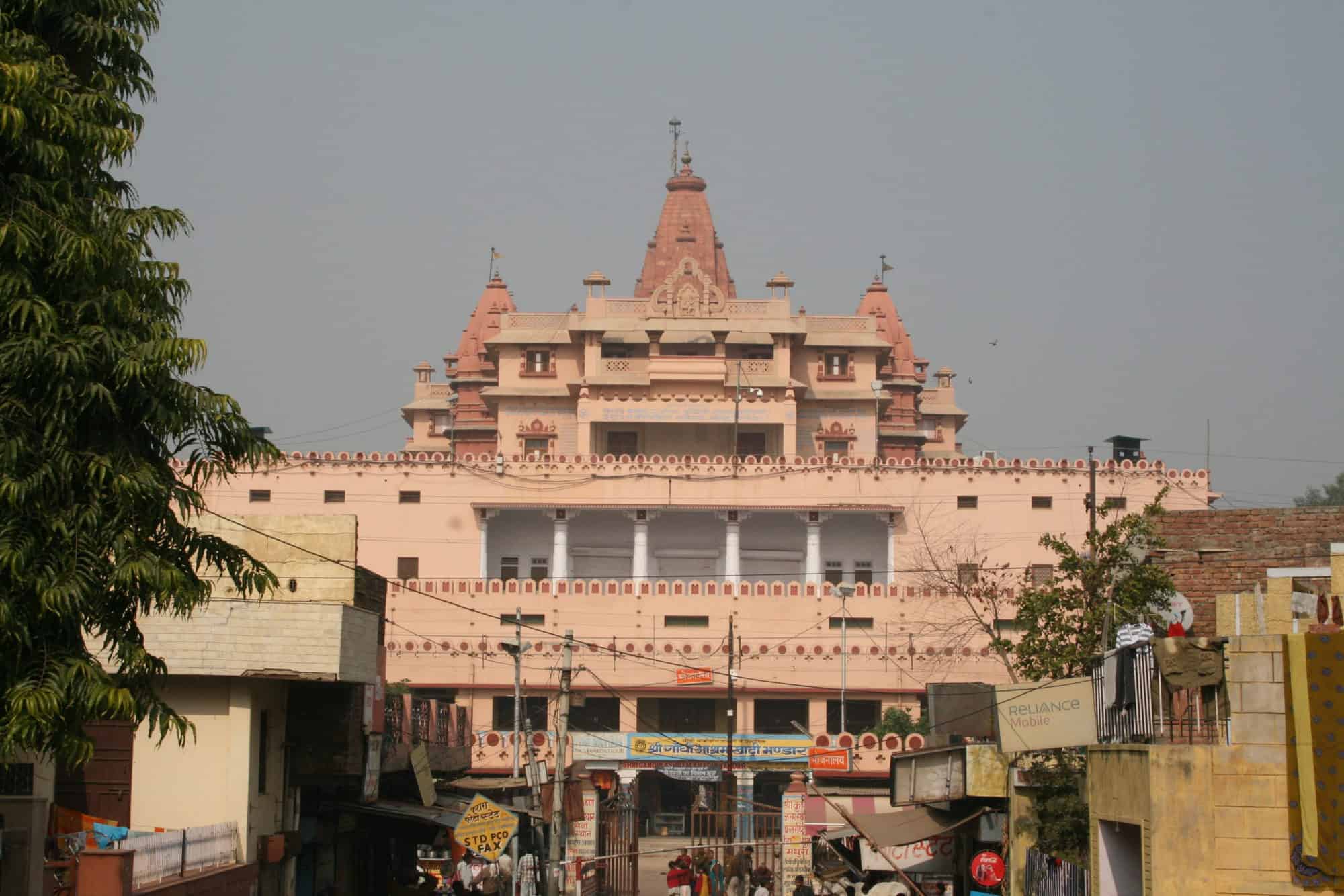
The Krishna Janmasthan Temple Complex is a group of Hindu temples in Mallapura, Mathura, Uttar Pradesh, India. These temples are built around the place where where Hindu deity Krishna is said to have been born.The place has held religious significance since the 6th century BC. The temples were destroyed multiple times throughout history, most recently by the Mughal emperor Aurangzeb in 1670. He erected an Eidgah mosque there. In 20th century, the new temple complex adjacent the mosque was built with the financial help from industrialists containing the Keshavdeva temple, the Garbha Griha temple at the birthplace and the Bhagavata Bhavan.
Read More About Krishna Janmabhoomi / Source
Badrinath Temple

Badrinath or Badrinarayan Temple is a Hindu temple dedicated to Vishnu which is situated in the town of Badrinath in Uttarakhand, India. The temple and town form one of the four Char Dham and Chota Char Dham pilgrimage sites. The temple is also one of the 108 Divya Desams dedicated to Vishnu, who is worshipped as Badrinath—holy shrines for Vaishnavites. It is open for six months every year (between the end of April and the beginning of November), because of extreme weather conditions in the Himalayan region. The temple is located in Garhwal hill tracks in Chamoli district along the banks of Alaknanda River at an elevation of 3,133 m (10,279 ft) above the mean sea level. It is one of the most visited pilgrimage centers of India, having recorded 1,060,000 visits.
The image of the presiding deity worshipped in the temple is a 1 ft (0.30 m), the black granite deity of Vishnu in the form of Badrinarayan. The deity is considered by many Hindus to be one of eight swayam vyakta kshetras, or self-manifested deities of Vishnu.Mata Murti Ka Mela, which commemorates the descent of river Ganges on mother earth, is the most prominent festival celebrated in the Badrinath Temple. Although Badrinath is located in North India, the head priest, or Rawal, is traditionally a Nambudiri Brahmin chosen from the South Indian state of Kerala. The temple was included in the Uttar Pradesh state government Act No. 30/1948 as Act no. 16,1939, which later came to be known as Shri Badarinath and Shri Kedarnath Mandir Act. The committee nominated by the state government administers both the temples and has seventeen members on its board.
The temple is mentioned in ancient religious texts like Vishnu Purana and Skanda Purana. It is glorified in the Divya Prabandha, an early medieval Tamil canon of the Azhwar saints from the 6th–9th centuries AD.
Read More About Badrinath Temple / Source
Malibu Hindu Temple

Malibu Hindu Temple, a temple of the Hindu god Venkateswara, built in 1981, is located in the city of Calabasas near Malibu, California, in the Santa Monica Mountains. It is owned and operated by the Hindu Temple Society of Southern California. Built in the traditional South Indian style, it is frequented by followers of Hinduism in Southern California. It is one of the largest Hindu temples in the Western hemisphere.The priests are situated and live on the grounds of the temple. The temple has many gatherings for ceremonies and provides numerous spaces for meditation and picnicking. It has a full stage for special cultural and Hindu programs.
Read More About Malibu Hindu Temple / Source
KedarnathTemple

Kēdārnāth Mandir (Kedarnath Temple) is a Hindu temple (shrine) dedicated to Shiva. Located on the Garhwal Himalayan range near the Mandakini river, Kedarnath is located in the state of Uttarakhand, India. Due to extreme weather conditions, the temple is open to the general public only between the months of April (Akshaya Tritiya) and November (Kartik Purnima, the autumn full moon). During the winters, the vigraha (deity) from Kedarnath temple is carried down to Ukhimath and where the deity is worshiped for the next six months. Kedarnath is seen as a homogenous form of Shiva, the ‘Lord of Kedarkhand’, the historical name of the region.The temple is not directly accessible by road and has to be reached by a 22 kilometres (14 mi) uphill trek from Gaurikund. Pony and manchan service is available to reach the structure. According to Hindu legends, the temple was initially built by Pandavas, and is one of the twelve Jyotirlingas, the holiest Hindu shrines of Shiva. It is one of the 275 Paadal Petra Sthalams, expounded in Tevaram. Pandavas were supposed to have pleased Shiva by doing penance in Kedarnath. The temple is one of the four major sites in India’s Chota Char Dham pilgrimage of Northern Himalayas. This temple is the highest among the 12 Jyotirlingas. Kedarnath was the worst affected area during the 2013 flash floods in North India. The temple complex, surrounding areas, and Kedarnath town suffered extensive damage, but the temple structure did not suffer any “major” damage, apart from a few cracks on one side of the four walls which was caused by the flowing debris from the higher mountains. A large rock among the debris acted as a barrier, protecting the temple from the flood. The surrounding premises and other buildings in the market area were heavily damaged.
Read More About KedarnathTemple / Source
Dhakeshwari Mandir (Dhaka)
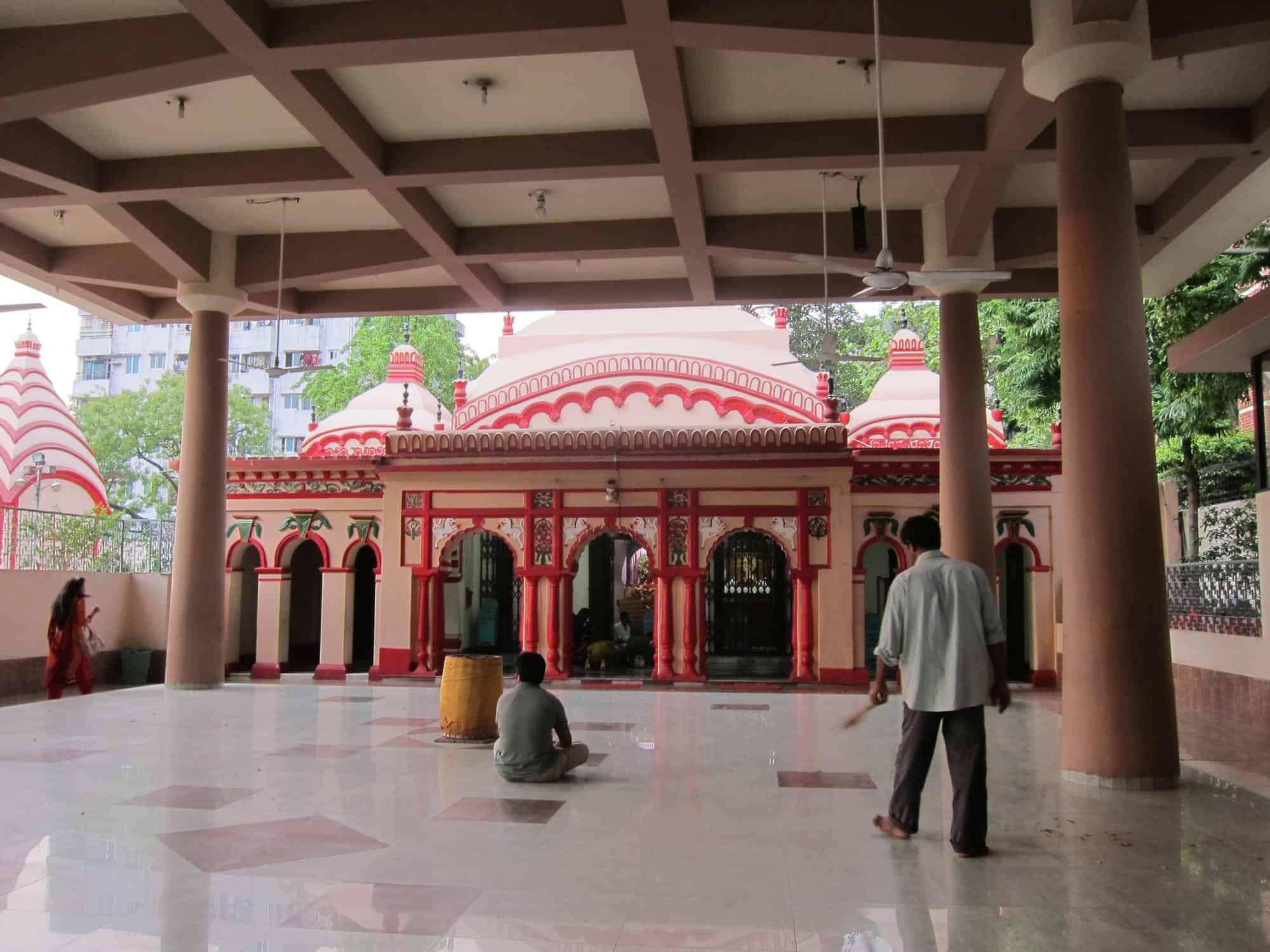
Dhakeshwari National Temple is a Hindu temple in Dhaka, Bangladesh. It is state-owned, giving it the distinction of being Bangladesh’s ‘National Temple’. The name “Dhakeshwari” means “Goddess of Dhaka”. Since the destruction of Ramna Kali Mandir in 1971 by the Pakistan Army during the Bangladesh Liberation War, the Dhakeshwari Temple has assumed status as the most important Hindu place of worship in Bangladesh. It is also the largest Hindu temple in Bangladesh. This temple is part of the famous Shakti Peethas in Indian Subcontinent. Here the gem of sati’s crown had fallen.
Read More About Dhakeshwari Mandir (Dhaka) / Source
Tungnath Temple
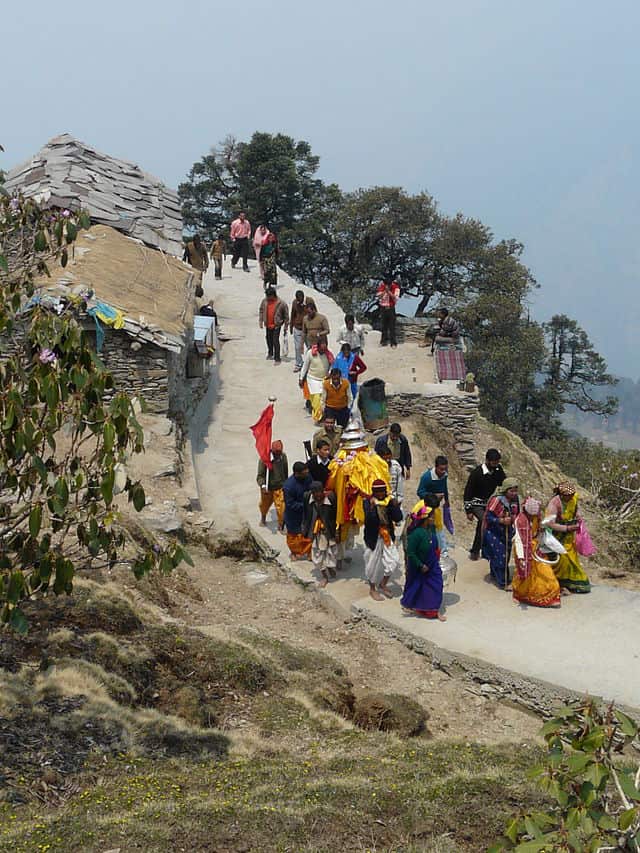
Kedarnath is one of the highest Shiva temples in the world and is the highest of the five Panch Kedar temples located in the mountain range of Tunganath in Rudraprayag district, in the Indian state of Uttarakhand. The Tunganath (literal meaning: Lord of the peaks) mountains form the Mandakini and Alaknanda river valleys. It is located at an altitude of 3,680 m (12,073 ft), and just below the peak of Chandrashila. and is the third (Tritiya Kedar) in the pecking order of the Panch Kedars. It has a rich legend linked to the Pandavas, heroes of the Mahabharata epic.
Read More About Tungnath Temple / Source
Vrindavan Chandrodaya Mandir
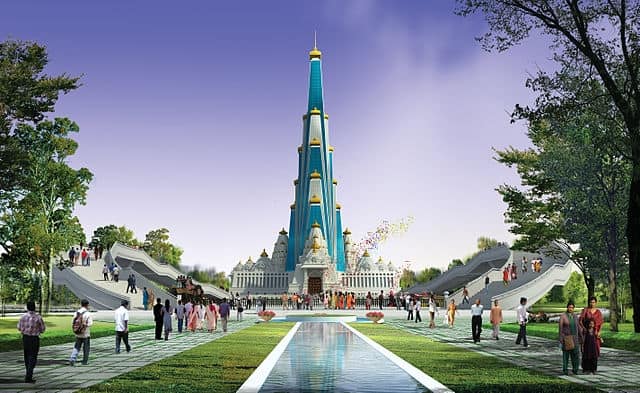
Vrindavan Chandrodaya Mandir is a temple under construction at Vrindavan, Mathura, India. As planned, it will be the tallest religious monument in the world. At its potential cost of ₹300 crore (US$42 million) it is likely to be one of the most expensive temples in world. The temple has been planned by ISKCON Bangalore. The planned effort includes the temple rising to a height of about 700 feet (213 meters or 70 floors) and a built-up area of 540,000 sq. ft. (~50,000 sq. m.) The project is set in 62 acres of land and includes 12 acres for parking and a helipad.
Read More About Vrindavan Chandrodaya Mandir / Source
Ellora Caves
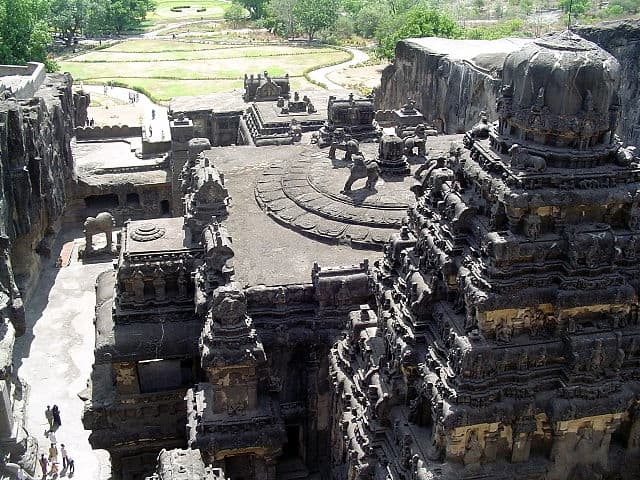
Ellora is a UNESCO World Heritage Site located in the Aurangabad district of Maharashtra, India. It is one of the largest rock-cut Hindu temple cave complexes in the world, featuring Hinduism in particular and few Buddhist and Jain monuments with Artwork dating from the 600–1000 CE period.
There are over 100 caves at the site, all excavated from the basalt cliffs in the Charanandri Hills, 34 of which are open to public. These consist of 17 Hindu (caves 13–29), 12 Buddhist (caves 1–12) and 5 Jain (caves 30–34) caves, each group representing deities and mythologies prevalent in the 1st millennium CE, as well as monasteries of each respective religion.
Read More About Ellora Caves / Source
Guruvayur Temple (Guruvayur)

Guruvayur Temple is a Hindu temple dedicated to the Lord Guruvayurappan (four-armed form of the Lord Vishnu), located in the town of Guruvayur in Kerala, India. It is one of the most important places of worship for Hindus in Kerala and is often referred to as Bhuloka Vaikunta (Holy Abode of Vishnu on Earth).
Read More About Guruvayur Temple (Guruvayur) / Source
Dharmrajeshwar

Dharmrajeshwar is an ancient Hindu cave temple site of 4th-5th century in Mandsaur district in Madhya Pradesh, India. Dharmrajeshwar Temple signifies brilliant example of Indian rock-cut architecture. This monolithic Temple has been constructed using solid natural rock, and the architecture is similar to Kailasa Temple, Ellora Caves. The main Temple houses a Shivaling and a murti of Bhagwan Vishnu, surrounded by 7 smaller shrines.
Read More About Dharmrajeshwar / Source

